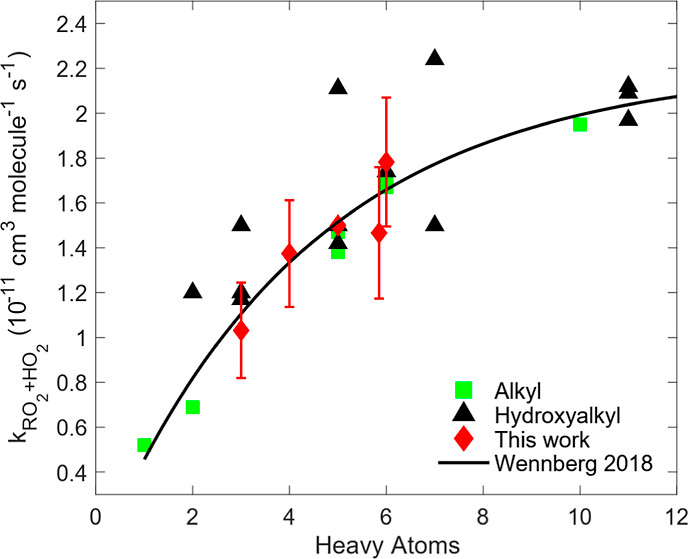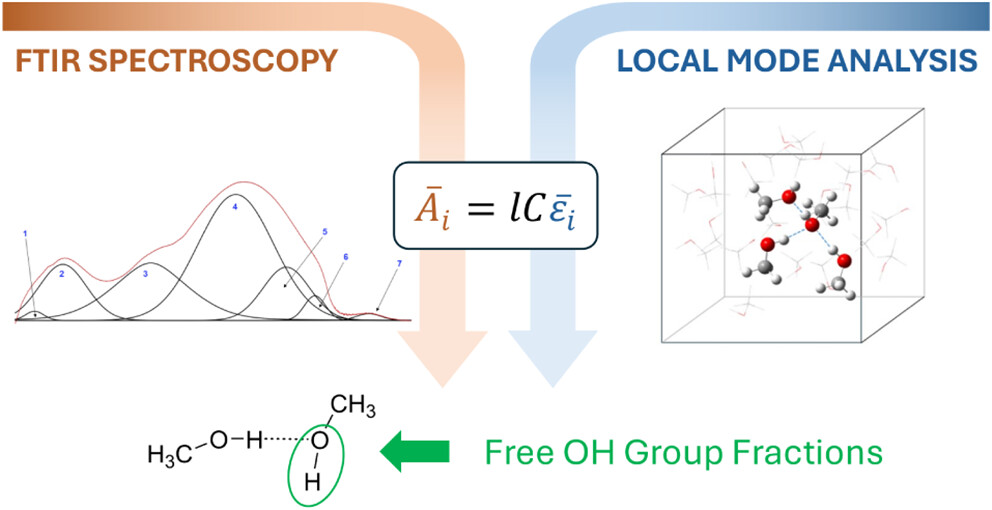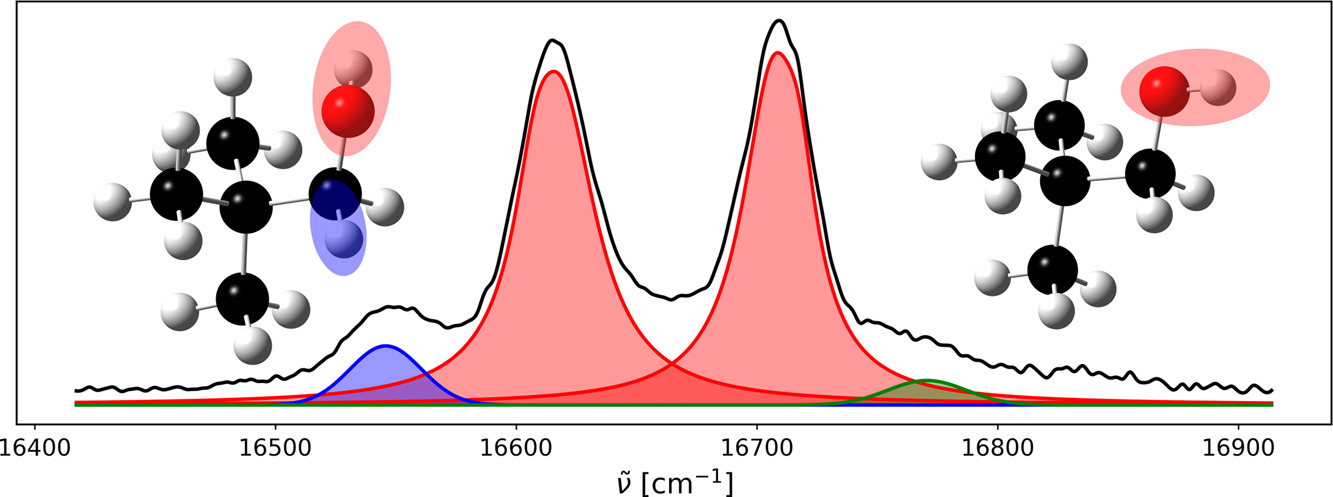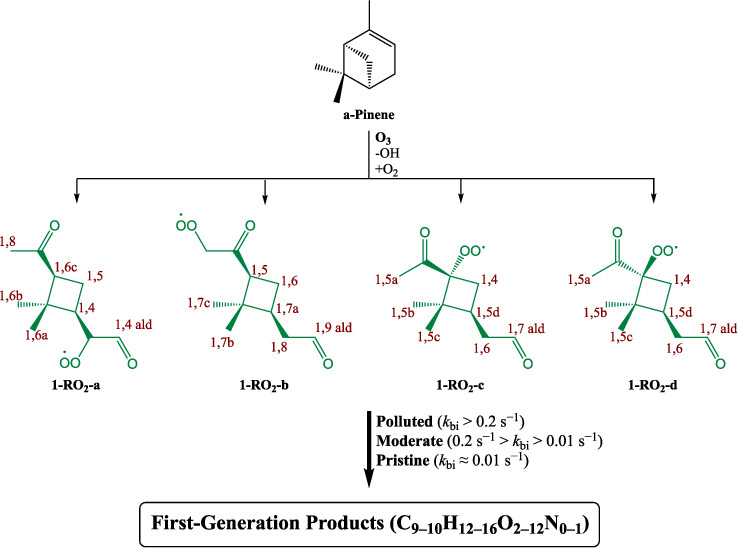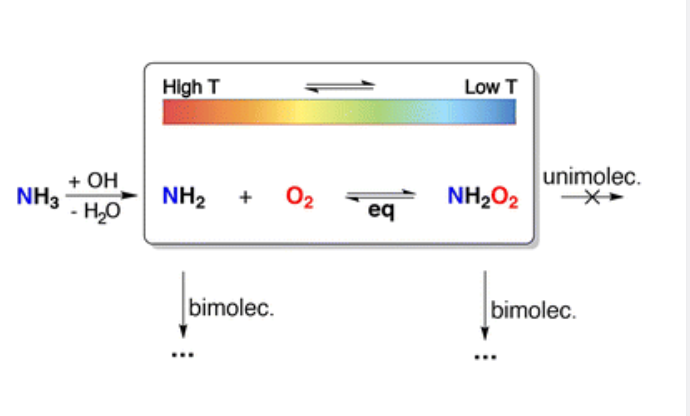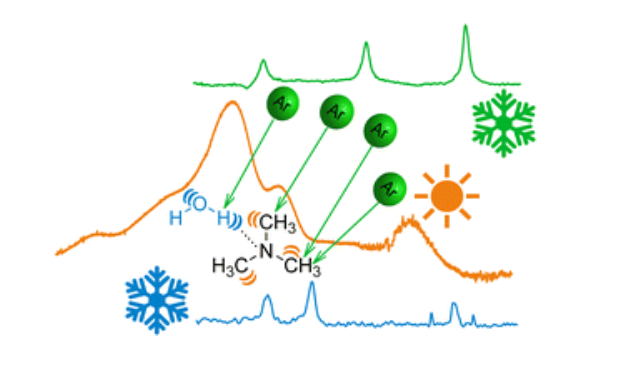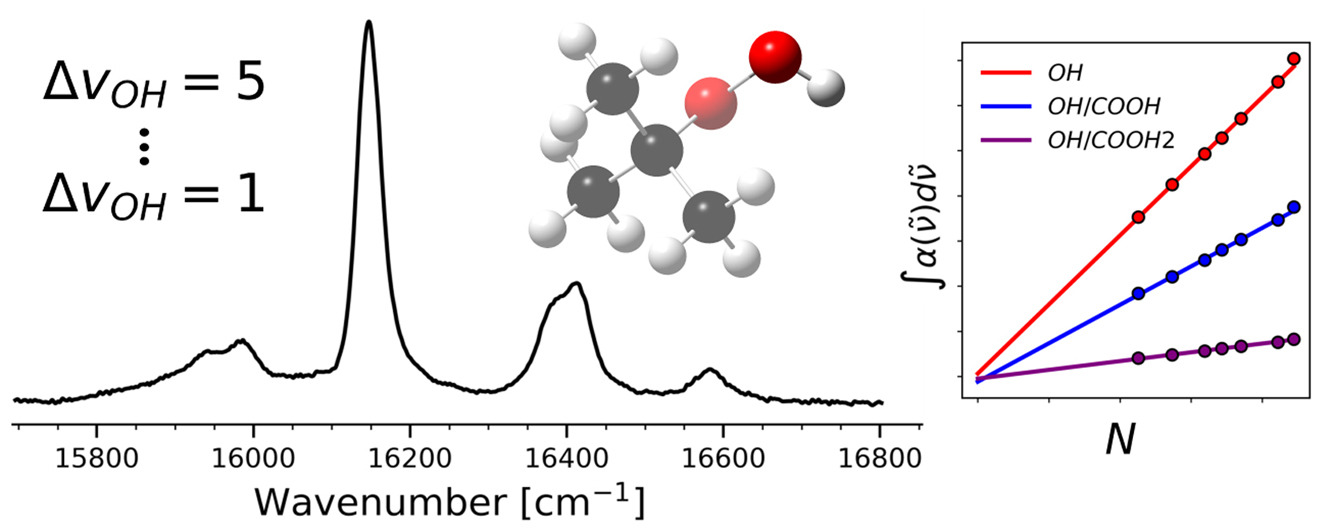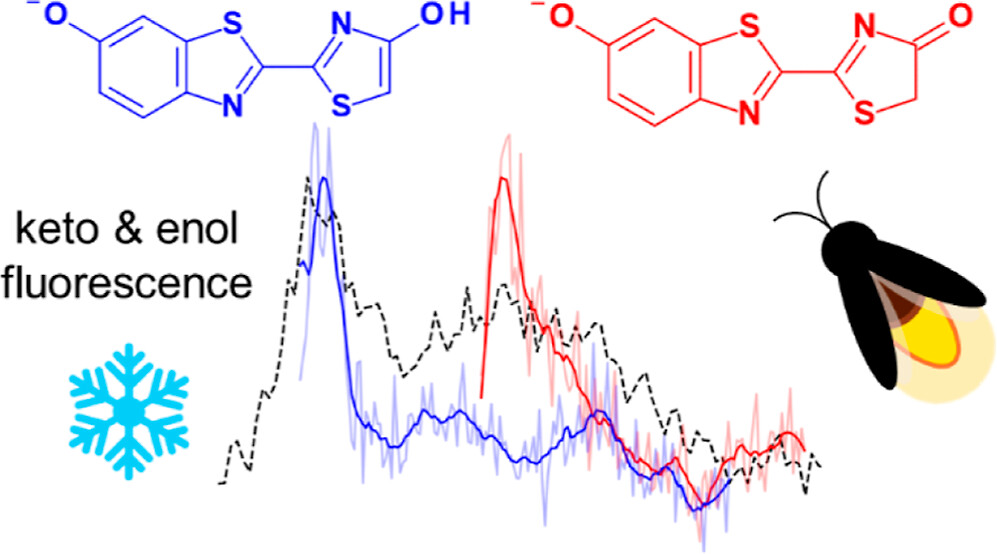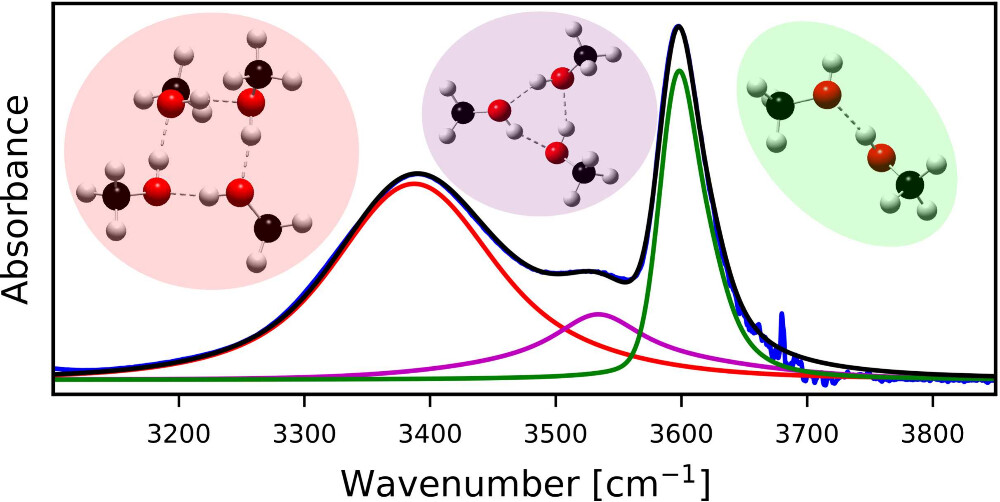
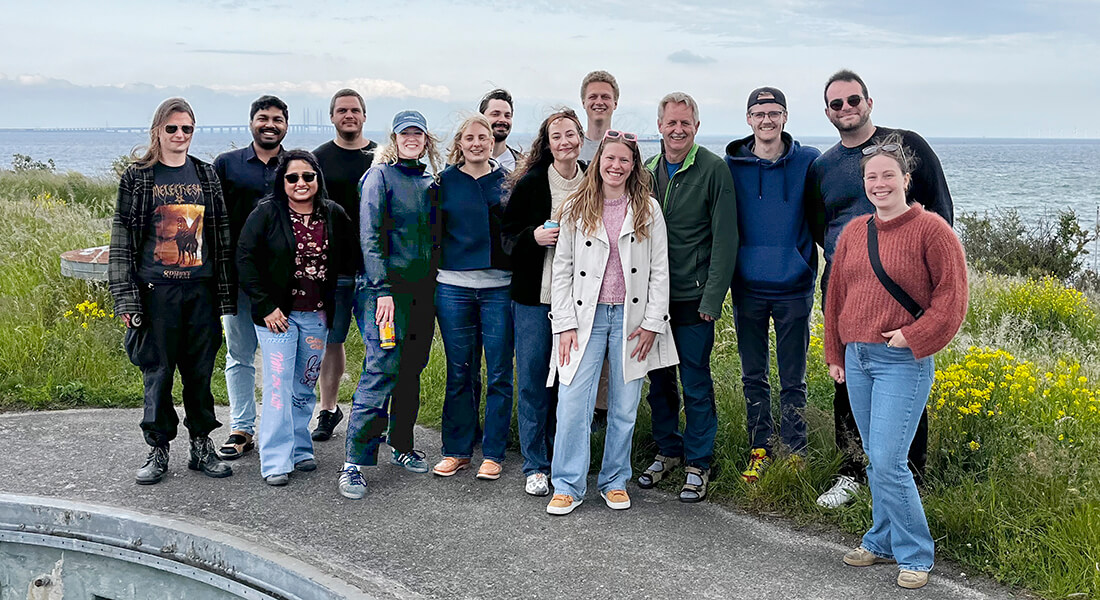
Kjaergaard Group
Welcome to the Kjaergaard Group research website
Our laboratories and offices are located on the north campus of the University of Copenhagen at the H. C. Ørsted Institute in Copenhagen.
We perform research in the field of physical chemistry. Our research is aimed at understanding atmospheric radical reactions. We are able to determine the reactivity of molecules and radicals in a range of different reactions by determining reaction rate constants. Our research is also aimed at determining properties of atmospheric molecules and hydrogen-bonded complexes to achieve a better understanding of the mechanisms of aerosol formation.
In The Kjaergaard group we are interested in the study of molecules, reactions and chemistry of atmospheric importance. Our current research is divided into two categories:
- Spectroscopy
Determining properties of molecules and hydrogen-bonded complexes, some of which are: absolute vibrational transition wavenumbers and intensities, enthalpies, entropies, and Gibbs energies of complex formation. We are able to obtain these properties by using various experimental and theoretical spectroscopic methods.
- Kinetics
Calculating reaction rates of unimolecular reactions such as atmospheric hydrogen shift reactions and ring breaking reactions. In order to do this, we use our recently developed cost-effective approach to the implementation of multi conformer transition state theory (MC-TST).
Spectroscopy
Absolute intensities of molecules

Spectra of the fundamental and first overtone of the NH-stretching vibration in dimethylamine.
With our full or reduced dimensional local mode (LM) models, we are able to determine accurate frequencies and intensities of various vibrational transitions. Of particular interest are the XH-stretching transitions, which typically provide most of the spectral intensity beyond ~2500 cm-1. XH-stretching vibrations have a characteristic high frequency relative to the additional molecular vibrations, and coupling to these vibrations is typically negligible. Thus, even the simplest LM model, i.e. a 1D LM model, often provides an accurate description of XH-stretching transitions. More vibrational modes are included in our LM models when an increased accuracy is needed, or when infrared spectra are difficult to assign solely based on experimental grounds. The absolute intensity of vibrational transitions is proportional to the integrated absorbance of the corresponding experimental band and inversely proportional to the pressure of the molecule. Absolute intensities of observable bands can therefore be determined experimentally by recording gas-phase FTIR spectra of isolated molecules.
Hydrogen-bonded complexes
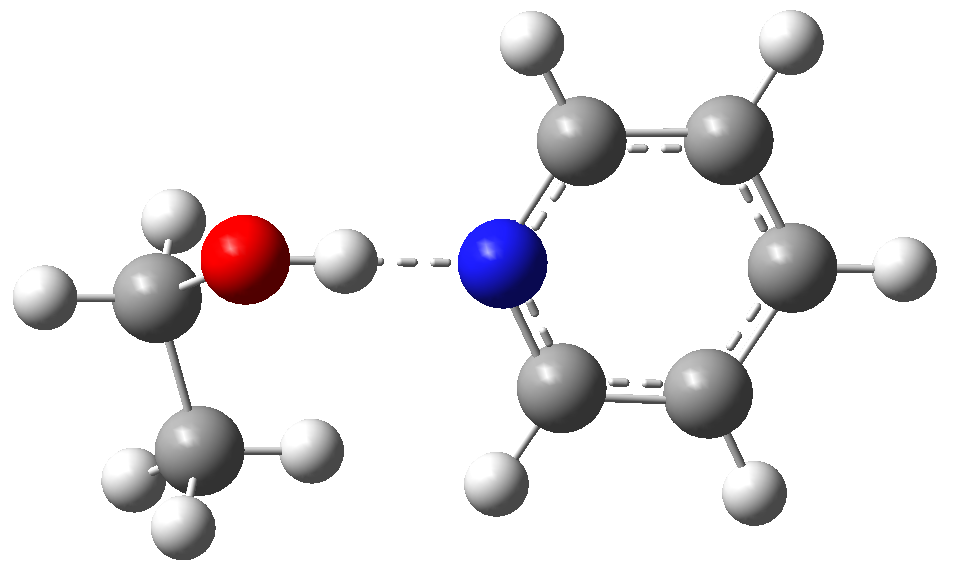
Hydrogen bonded complex with ethanol as the acceptor molecule and pyridine as the donor molecule.
Networks of hydrogen-bonded molecules are found in molecular clusters in the atmosphere and the thermodynamic stability of the clusters is determined by the strength of the formed hydrogen bonds. The molecular clusters are precursors to aerosols, which have a huge impact on our climate due to their ability to absorb and scatter solar radiation. Aerosol particles remain large sources of uncertainty in climate models today and determining the hydrogen bonding abilities of a range of different molecules will help limit these uncertainties and thereby improve current climate models.
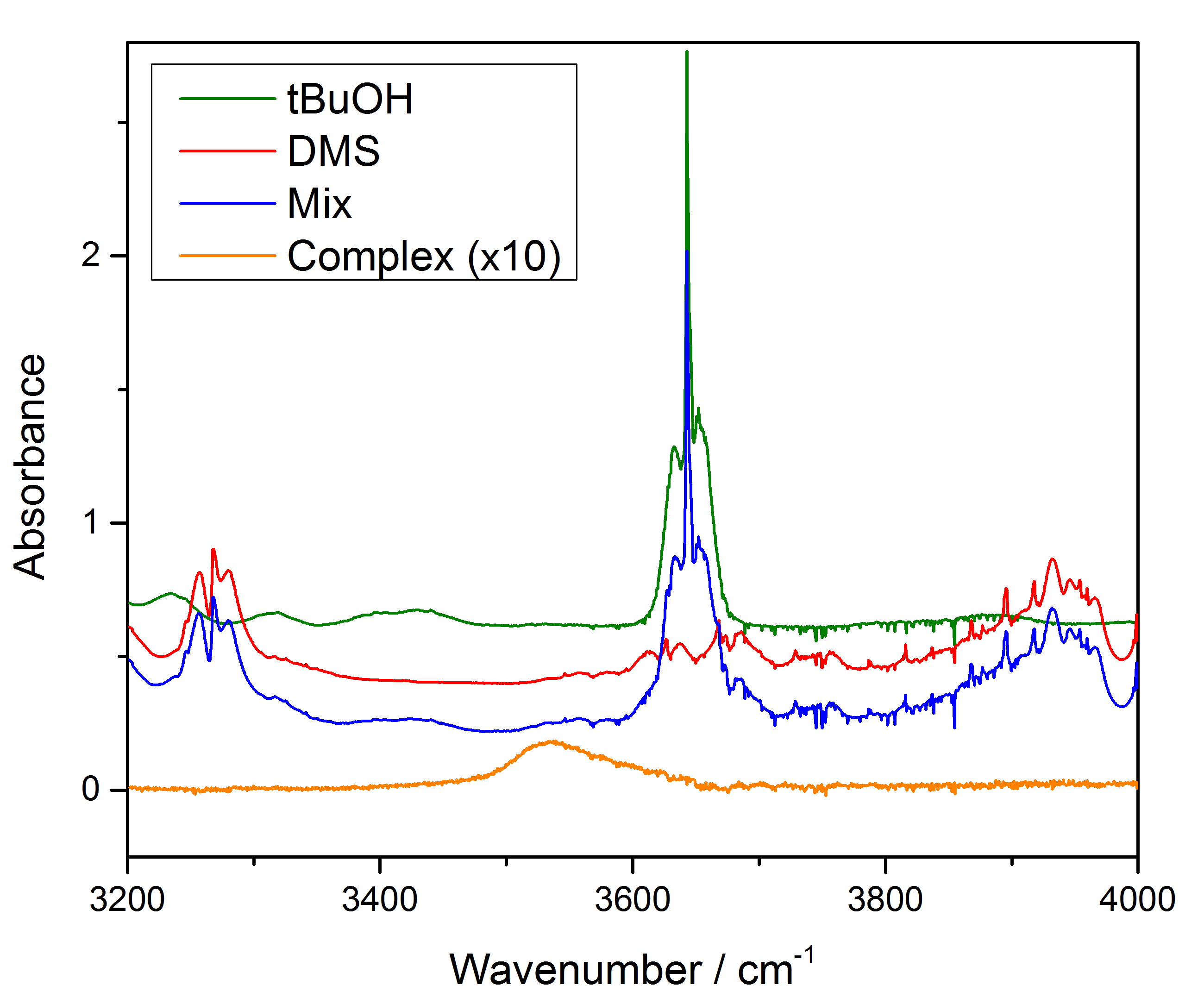
The complex of t-butanol (tBuOH) and dimethylsulfide (DMS) is detected by subtracting the monomer spectra (green and red) from a mixture spectrum (blue), resulting in a spectrum of the complex (orange).
In order to achieve a better understanding of the formation of clusters in the atmosphere, the Kjaergaard group have investigated a number of different hydrogen bonded complexes in the gas phase and determined the equilibrium constant of their formation to help predict if they play a significant role in cluster formation and growth in the atmosphere. In the group we use conventional absorption spectroscopy as well as matrix isolation spectroscopy to examine the complexes as well as theoretical investigations using our local mode model to predict wavenumbers and oscillator strengths of molecular vibrations.
We use conventional FTIR spectroscopy to examine hydrogen bonded complexes as well as matrix isolation spectroscopy, which is helpful when detecting very unstable complexes.
Kinetics
Autoxidation in the atmosphere (Multi-conformer transition state theory)
Reduced carbon species are emitted to the atmosphere from biogenic and anthropogenic sources in huge quantities. These are oxidized in the atmosphere by various different processes such as autoxidation reactions (repeated addition of O2 and H-shifts to a molecule), and the oxidized products have a much lower volatility than the reduced species. Low-volatility compounds play a significant role in the growth of secondary organic aerosols (SOA). SOA affect the radiative balance of the earth, yet quantitative assessment of the effect of SOA on the climate remains a challenge.
In the Kjaergaard group we calculate rate constants of various different radical hydrogen shift reactions in order to determine the most likely products, which are formed from the autoxidation of different reduced carbon species. This contributes to understanding of the processes which happen in the atmosphere and the way that the formed species affect the radiative balance of the earth.
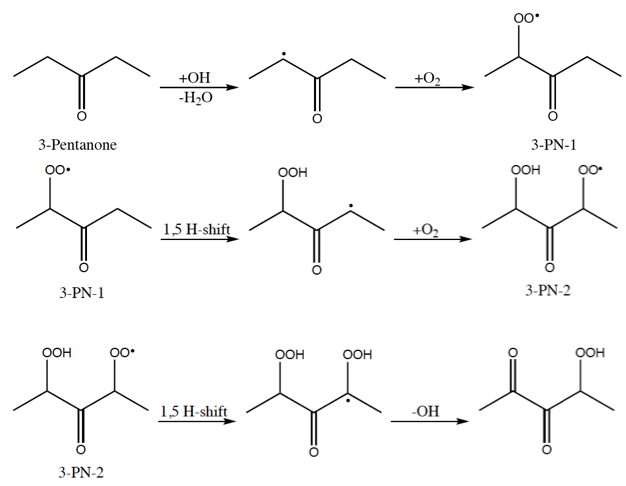
The autoxidation of 3-pentanone.
One of the processes we have studied, is the autoxidation of 3-pentanone (shown in the picture above) with the final reaction product being 4- hydroperoxypentane-2,3-dione. Addition of O2 to radical species happens very fast, making the radical hydrogen shift reaction the ones that determine the overall rate of the autoxidation. In order to determine the rate constants of the hydrogen shift reactions we have developed a cost-effective approach to the implementation of multi conformer transition state theory (MC-TST), which includes tunneling.
Transition Intensities in the Local Mode Picture 
Emil Vogt, 2019
 Identification of OSSO as a Near-UV Absorber in the Venusian Atmosphere
Identification of OSSO as a Near-UV Absorber in the Venusian Atmosphere
Benjamin N. Frandsen, 2016
 Gas Phase Detection of the NH···P Hydrogen Bond and Importance of Secondary Interactions
Gas Phase Detection of the NH···P Hydrogen Bond and Importance of Secondary Interactions
Kristian H. Møller, 2015
 Effect of Fluorine Insertion in Alcohol-Amine
Effect of Fluorine Insertion in Alcohol-Amine
Complexes
Sofie N. Gottfredsen, 2015
 Intramolecular Hydrogen Bonding in Methyl Lactate
Intramolecular Hydrogen Bonding in Methyl Lactate
Jens H. Wallberg, 2015
 Rapid Hydrogen Shift Scrambling in Hydroperoxy Substituted Organic Peroxy Radicals
Rapid Hydrogen Shift Scrambling in Hydroperoxy Substituted Organic Peroxy Radicals
Rasmus V. Otkjær, 2015
Group Leader
 Professor Henrik G. Kjærgaard
Professor Henrik G. Kjærgaard
Email: hgk@chem.ku.dk
Office: C418
Phone: +45 35 32 03 34
Henrik received his PhD in molecular physics from Odense University in Denmark, 1992. Then followed 4 years as a post doctoral fellow at the University of Guelph, Canada. He arrived in Dunedin late 1996 to take up a position as Lecturer in Chemistry and started the Viking research group. He moved to Copenhagen, Denmark and became a Professor at the University of Copenhagen and started The Kjaergaard Group in 2009.
Postdoctoral Fellows
 Dhritabrata Pal
Dhritabrata Pal
Email: dp@chem.ku.dk
Office: C412
Pal joined the group in 2024 as a Postdoc. He obtained his Ph.D. from Birla Institute of Technology and Science, Pilani, Rajasthan, India. He is concerned with the experimental investigation of molecules and interactions of atmospheric and interstellar interest. He is utilizing a range of techniques such as conventional FT-IR, UV-Vis, Cavity Ring-Down, and Matrix Isolation for his work.
Freja Chabert Østerstrøm
Email: fcoe@chem.ku.dk
Office: C414
Freja joined the group in 2023. She is using 3D chemistry modelling to investigate different atmospheric changes with relevance for air pollution and climate. Currently, she is running a chemistry-climate model to investigate the impact of volcanic eruptions on the stratosphere and working on using the GEOS-Chem chemical transport model to evaluate impacts of new mechanisms on atmospheric chemistry.
Jing Chen
Email: lcg358@alumni.ku.dk
Office: C414
Jing joined the group in 2019 as a Ph.D. student. Her work focuses on the theoretical computation of the atmospheric oxidation mechanism of volatile organic compounds such as terpenes and organic sulfides, as well as how will the atmospheric gas-phase oxidation mechanism apply to the residential indoor environment and its impact on humans.
PhD. Students
 Vili-Taneli Salo
Vili-Taneli Salo
Email: vili-taneli.salo@helsinki.fi
Office: C412
External supervisor: Theo Kurtén
Vili joined the group in Summer 2023 as a visiting researcher / PhD Student from Atmospheric Computational Chemistry Group at University of Helsinki. He studies complicated electronic structures using various computational tools, such as CASPT2 and other multireference methods. Most of his research projects revolve around atmospherically relevant reaction systems.
 Nanna Falk Christensen
Nanna Falk Christensen
Email: gqb552@alumni.ku.dk
Office: C414
Nanna joined the group in 2019. She works with vibrational and electronic spectroscopy of dimethyl sulfides in the gas phase and using matrix isolation.
 Casper Vindahl Jensen
Casper Vindahl Jensen
Email: zls129@alumni.ku.dk
Office: C412
Casper joined the group in 2020. Casper is concerned with experimental work determining oscillator strengths of fundamental- and overtone vibrational transitions of organic peroxides. Casper utilizes a range of techniques such as Conventional FT-IR and UV-VIS, Cavity Ring-Down and Matrix Isolation.
Master Students
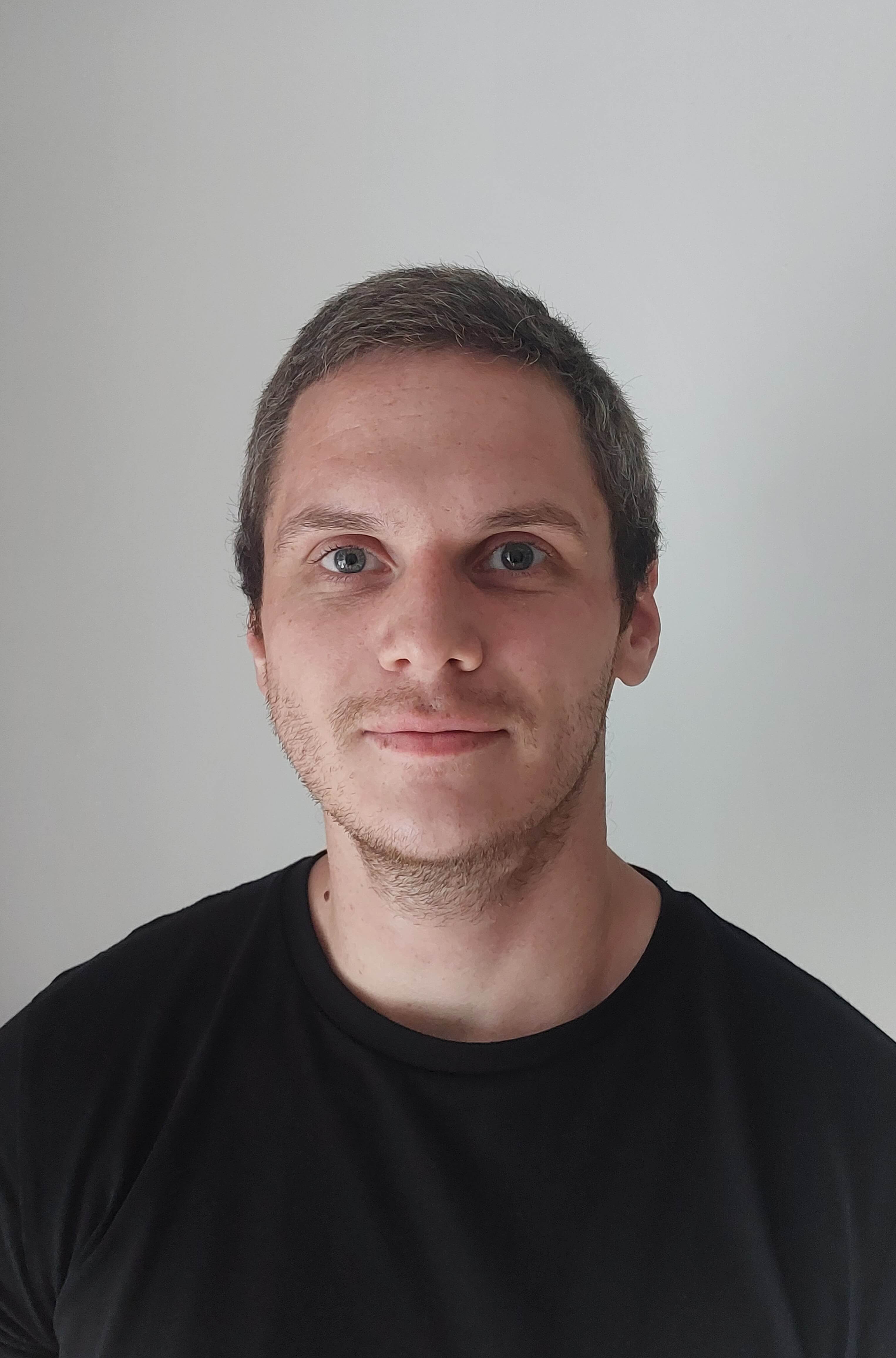 Andras Sun Poulsen
Andras Sun Poulsen
Email: ansp@chem.ku.dk
Office: C412
Andras joined the group in 2022 and is working on equilibrium constants of formation for small alcohol clusters. Andras utilizes FT-IR and other techniques in combination with computational calculations.
In addition to this work Andras is responsible for the groups website and other tasks pertaining to the group.
 Ružica Marković
Ružica Marković
Email: ftq203@alumni.ku.dk
Office: C414
Ružica joined the group in 2024 and is working with vibrational perturbation theory with applications to hydrogen bonded systems.
 Vera Staun Hansen
Vera Staun Hansen
Email: vsh@chem.ku.dk
Office: C414
Vera joined the group in 2023 where she uses matrix isolation in combination with FT-IR spectroscopy to study astrochemically relevant species.
Bachelor Students
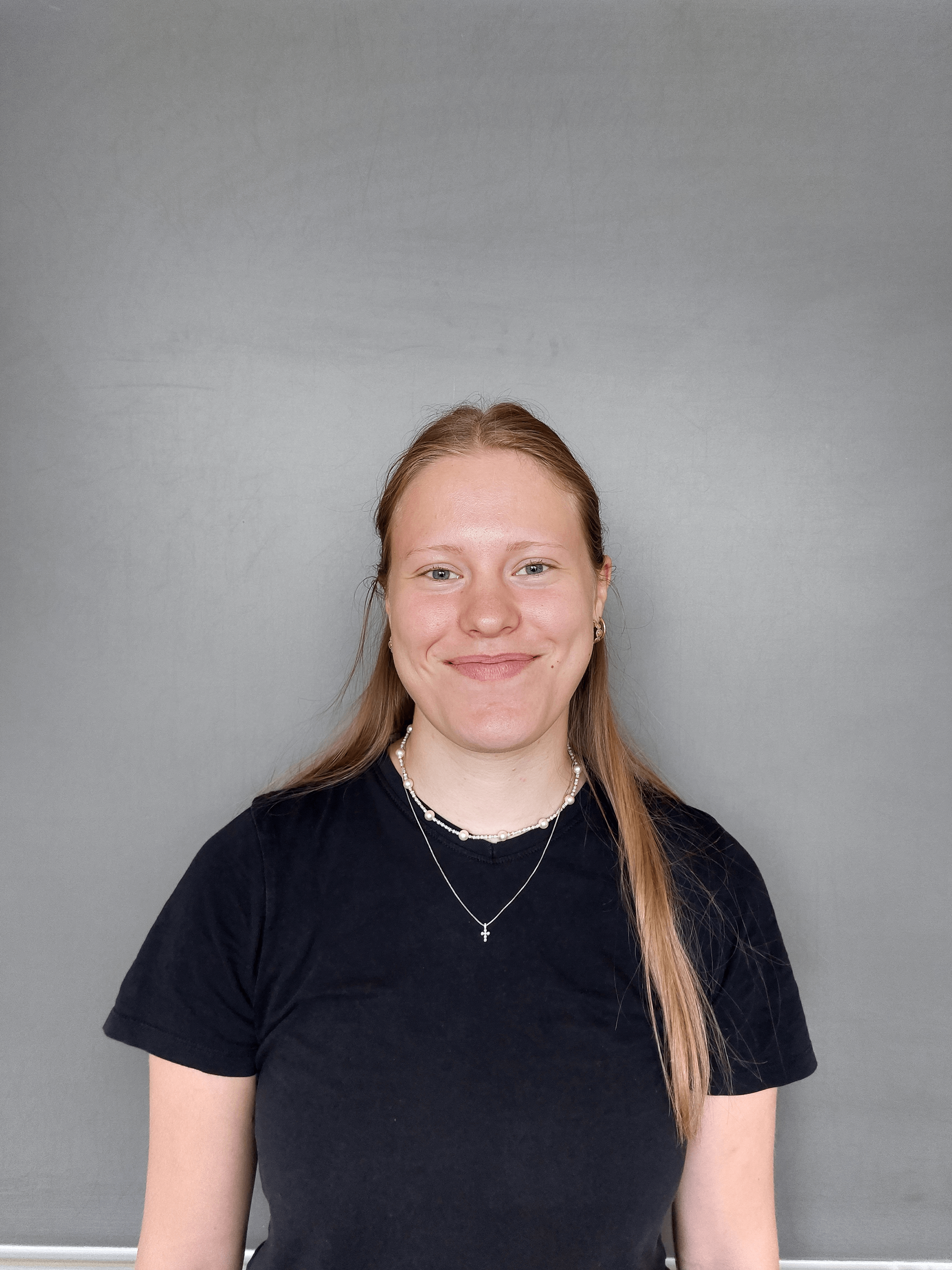 Amalie Rosager Kristensen
Amalie Rosager Kristensen
Email: ark@chem.ku.dk
Office: C414
Amalie joined the group in 2024 and is investigating water-diethylether complexes in the gas phase and in matrix isolation experiments in combination with theoretical calculations.
Bachelor Students
Andreas Thirstrup Simonsen
Email: jrm214@alumni.ku.dk
Office: C408
Andreas joined the group in 2020. He worked together with Tine Elmelund Christensen, looking at vibrational spectroscopy of water-amine hydrogenbound complexes to determine the enthalpy and the Gibbs energy of complex formation. He is now working on the spectroscopy of methanol complexes.
 Catriona Ann O'Shea
Catriona Ann O'Shea
Email: qkl855@alumni.ku.dk
Office: C406
Catriona joined the Kjærgaard Group in late 2020, while doing a research project on O-H bonds in dimethlyether bimolecular complexes, and continued her work to determining oscillator strengths of fundamental- and overtone vibrational transitions of water- dimethlyether, using FT-IR spectroscopy, for her B.Sc. Project.
 Margrete Juel Henrichsen
Margrete Juel Henrichsen
Email: mnr410@alumni.ku.dk
Office: C406
Luisa joined the group in 2020 doing a research project on the spectroscopy of the CH-stretches in isoprene.
 Luisa Pennacchio
Luisa Pennacchio
Email: rkt505@alumni.ku.dk
Office: C412
Luisa joined the group in 2020 doing a joint B.Sc. project with Ole John Nielsen and Kristian Møller, and investigated the atmospheric chemistry of N-methyl pyrrolidinone both experimentally and computationally.
 Allison Moyer
Allison Moyer
Email: amoyer@email.wm.edu
Office: C408
Allison joined the group in 2020. She investigated the atmospheric importance of dimethyl sulfides using matrix isolation, FT-IR spectroscopy, and UV-visible spectroscopy.
 Axel Alejandro Andersen Arias
Axel Alejandro Andersen Arias
Email: bfv248@alumni.ku.dk
Office: C406
Axel joined The Kjærgaard Group in 2020 and was through his B.Sc. project doing research on the C-H bonds vibrational fundamental and overtone spectroscopic transitions in isoprene, using FT-IR spectroscopy.
 Helene Hagemann
Helene Hagemann
Email: jgn242@alumni.ku.dk
Office: C412
Helene was part of the group in 2016 and 2017 while doing a research project and her B.Sc. Project in the group. Helene used computational methods to determine rate constants of radical reactions of atmospheric relevance. She used multi conformer transition state theory to calculate the rate constants.
Casper Voigt Winder
Email: wzm658@alumni.ku.dk
Office: C408
Casper was with the group in 2016 when he did his bachelors thesis. Casper examined OH-stretching overtones using UV-VIS and FTIR spectroscopy.
- Annesofie M. Jensen
- Cecilie L. Andersen
- Svend Bager
- Camilla M. Tram
Master Students
Anisha Lyer
Email: qkl463@alumni.ku.dk
Office: 412
Anisha joined the group in 2022 working on the absorption spectra of isoprene and methanol. Anisha used the FT-IR UV-VIS to determine the spectra of these, with the focus being on uses for furthering our understanding of the atmospheres of exoplanets.
 Pablo Bertran Valls
Pablo Bertran Valls
Email: hgk892@alumni.ku.dk
Office: C408
Pablo joined the group in 2019. He worked on different OH-stretching transitions of aromatic alcohols that are likely to be present in the atmosphere. Following his graduation, Pablo worked as a research assistant in the group.
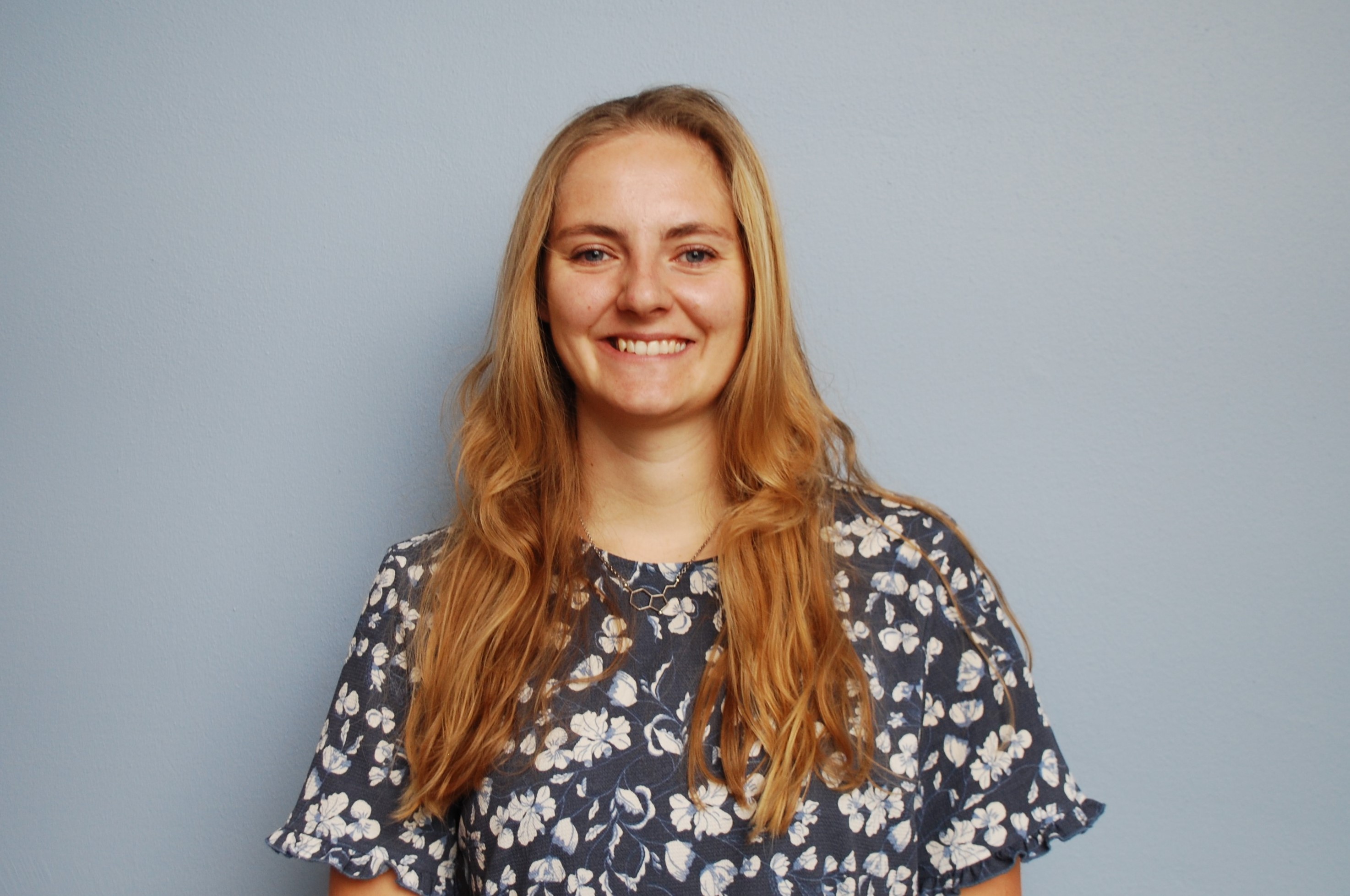 Eva Rosendal Kjærgaard
Eva Rosendal Kjærgaard
Email: rwq213@alumni.ku.dk
Office: C412
Eva joined the group in 2019. She did a joint M.Sc. project with Ole John Nielsen and Kristian Møller, investigating the atmospheric chemistry of selected amines both experimentally and computationally.
 Tine Elmelund Christensen
Tine Elmelund Christensen
Email: zjc115@alumni.ku.dk
Office: C406
Tine joined the group in 2020. She worked with vibrational spectroscopy of water-amine hydrogenbound complexes to determine the enthalpy and the Gibbs energy of complex formation.
 Sofie Markussen
Sofie Markussen
Email: hlx580@alumni.ku.dk
Office: C406
Sofie joined the group in 2020. She used local mode theory to determine vibrational transition energies and oscillator strengths of CH-streches.
Emilie Lolk Wolff-Sneedorf
Email: wmn494@alumni.ku.dk
Office: C414
Emilie was with the group from 2017 to 2019 doing her master's thesis entitled: "A Matrix-Isolation Approach to Explore the Molecular Landscape". Emilie investigated conformational switching and hydrogen-bound complexes under matrix-isolation conditions. Emilie also made a new design for the experimental setup in which both FTIR and UV/Vis spectroscopy can be done on the same matrix.
 Evan James Yuhas
Evan James Yuhas
Email: zlx841@alumni.ku.dk
Office: C412
Evan was with the group from 2016 to 2017 as he did his masters thesis here. Evan combined experimental and theoretical spectroscopy to determine the vapour pressure of low vapour pressure compounds.
 Leon Søllegaard Andersen
Leon Søllegaard Andersen
Email: zxm766@alumni.ku.dk
Office: C414
Leon became part of the group in 2015 when he started doing his bachelors thesis here. In 2017, He finished his masters thesis in the group, where he examined alcohol-amine hydrogen bonded complexes at different temperatures to determine the enthalpy and entropy of their formation.
- Camilla Jensen
- Christine S. Jensen
- Hasse C. Knap
- Helena Sodergren
- Kristian B. Ørnsø
- Lasse B. Nielsen
- Nini E. A. Reeler
- Rasmus M. Borup
- Sofie N. Gottfredsen
- Zeina Maroun
PhD Students
 Emil Vogt
Emil Vogt
Email: bvh517@alumni.ku.dk
Office: C406
Emil is determining oscillator strengths and band profiles of XH-stretching transitions in hydrogen-bound complexes using local mode theory. Emil has also worked on XH-stretching vibrations of isolated molecules. He did his bachelor project on the Deng-Fan potential, an alternative to the conventional Morse potential for analytically describing the potential energy surface of stretching vibrations.
Alexander Kjærsgaard
Email: pml305@alumni.ku.dk
Office: C408
Alexander was a member of the group from 2016-2022. Alexander used experimental and theoretical spectroscopic techniques to examine hydrogen bonded complexes in the gas phase.
Kristian Holten Møller
Email: khm@chem.ku.dk
Office: C412
Kristian was a member of the Kjærgaard group from 2014-2022. He did his bachelor thesis with the group. Kristian developed a cost-effective approach to multi conformer transition state theory (MC-TST), which can be employed to determine accurate rate constants of atmospheric radical H-shift reactions. Kristian also examined hydrogen-bonded species using various different spectroscopic techniques.
Benjamin Normann Frandsen
Email: bnf@chem.ku.dk
Office: C406
Benjamin was a member of the group from 2014 to 2019. Benjamin combined theoretical and experimental spectroscopy to determine properties of different molecules and hydrogen-bonded complexes.
Jens Windeløv Wallberg
Email: wallberg@chem.ku.dk
Office: C408
Jens was a member of the group from 2013-2019. Jens constructed a Cavity Ring-Down spectrometer as part of his masters project and later used it to examine intramolecular hydrogen bonds and overtone spectra of alcohols and amines.
 Rasmus V. Otkjær
Rasmus V. Otkjær
Email: otkjaer@chem.ku.dk
Office: C412
Rasmus was a member of the Kjærgaard group from 2013-2019. Rasmus developed a cost-effective approach to multi conformer transition state theory (MC-TST), which can be employed to determine accurate rate constants of atmospheric radical H-shift reactions.
 Anne Schou Hansen
Anne Schou Hansen
Email: anne.schou@chem.ku.dk
Office: C414
Anne was a member of the group from 2011 to 2018, beginning with a research project in the group. She then went on to finish her bachelor and master and Ph.D. degree in the group. Anne examined molecules and hydrogen bonded complexes in the gas phase using various spectroscopic methods such as FTIR spectroscopy and Matrix Isolation spectroscopy.
- Anna L. Garden
- Ben Miller
- Ditte L. Thomsen
- Kasper Mackeprang
- Mivsam Yekutiel
- Sidsel D. Schrøder
- Timothy W. Robinson
- Zimei Rong
Postdoctoral Fellows
- Daniel P. Schofield
- Daryl L. Howard
- Joseph R. Lane
- Lin Du
- Nicolai Bork
- Rene W. Larsen
Publications
Click the TOC figures to access full texts.
255. Atmospheric Autoxidation Chemistry of Diethyl Ether
Hongmin Yu, Jing Chen, John D. Crounse, Thomas Golin Almeida, Henrik G. Kjaergaard, Paul O. Wennberg
ACS EST Air, 2, 11, 2566–2576 (2025), DOI: 10.1021/acsestair.5c00204
254. Relative Rate Coefficients for the Reactions of HO2 Radicals with Hydroxy-Substituted Alkyl Peroxy Radicals, and for Reactions of OH Radicals with Hydroxy Hydroperoxides
Geoffrey S. Tyndall, John D. Crounse, Theo Kurtén, Henrik G. Kjaergaard, Paul O. Wennberg
ACS EST Air, 2, 10, 2219–2229 (2025), DOI: 10.1021/acsestair.5c00158
253. Application of the Local Vibrational Mode Framework for the Spectroscopic Estimation of Free Hydroxyl Group Fractions in Pure Liquid Methanol-d3
Evangelos Drougkas, Henrik G. Kjaergaard, Henrik G. Bohr, Michael Bache, Nicolas Von Solms, Georgios M. Kontogeorgis, Xiaodong Liang
J. Phys. Chem. B, 129, 41, 10824–10837 (2025), DOI: 10.1021/acs.jpcb.5c03059
252. OH-stretching Overtone Spectra of Primary and Secondary Alcohols
Casper Vindahl Jensen, Emil Vogt, Pablo Bertran Valls, Henrik G. Kjaergaard
Spectrochimica Acta Part A: Molecular and Biomolecular Spectroscopy, 346, 126873 (2026), DOI: 10.1016/j.saa.2025.126873
251. Theoretical Mapping of the Gas-Phase Ozonolysis of α-Pinene: Formation of First-Generation Products under Different Atmospheric Conditions
Jing Chen, Christopher M. Kenseth, Joel A. Thornton, Henrik G. Kjaergaard
ACS EST Air, 2, 8, 1625–1639 (2025), DOI: 10.1021/acsestair.5c00101
250. Formation of the Aminoperoxyl Radical in the Atmospheric Oxidation of Ammonia
Vili-Taneli Salo, Jing Chen, Henrik G. Kjaergaard
Environ. Sci.: Atmos., 5, 848-856 (2025), DOI: 10.1039/D5EA00042D
249. OH-stretching Dynamics in Trimethylamine Monohydrate: What Can We Learn from Three Different Direct Absorption Spectra?
Taija L. Fischer, Casper V. Jensen, Eaindra Lwin, Dhritabrata Pal, Henrik G. Kjaergaard, Martin A. Suhm
Phys. Chem. Chem. Phys., 27, 11487-11491 (2025), DOI: 10.1039/D5CP01424G
248. Room Temperature Gas-phase Detection and Formation Gibbs Energy of the Water Dimethyl Ether Bimolecular Complex
Alexander Kjaersgaard, Dhritabrata Pal, Emil Vogt, Tine Elmelund Skovbo, Henrik G. Kjaergaard
J. Phys. Chem. A, 129, 20, 4438–4446 (2025), DOI: 10.1021/acs.jpca.5c01130
247. Oscillator Strengths of the Fundamental and Overtone OH-stretching Bands of tert-Butyl Hydroperoxide in Gas Phase
Casper Vindahl Jensen, Emil Vogt, Henrik G. Kjaergaard
Journal of Molecular Spectroscopy, 409, 112009 (2025), DOI: 10.1016/j.jms.2025.112009
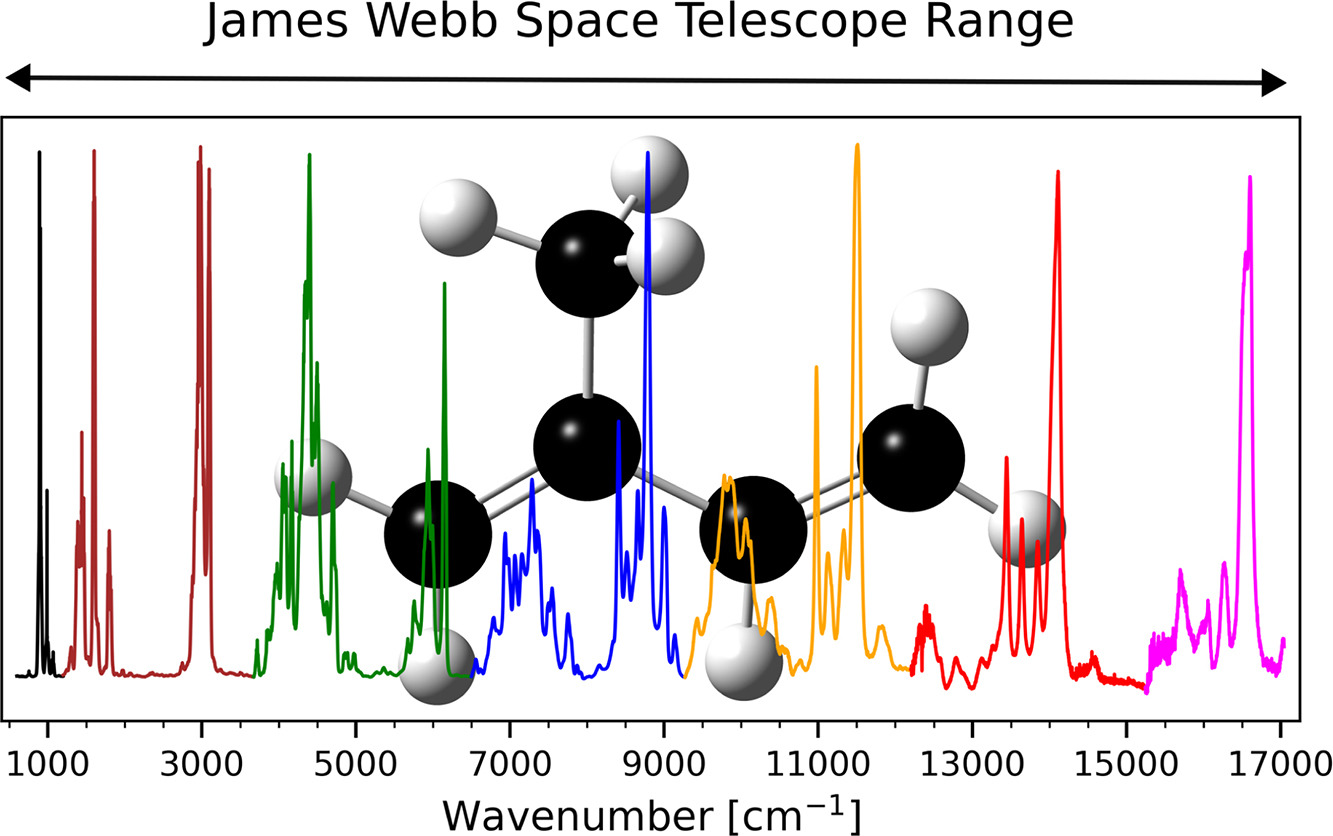 246. Absorption Cross Section of Gas Phase Isoprene in the Infrared-visible Range
246. Absorption Cross Section of Gas Phase Isoprene in the Infrared-visible Range
Casper Vindahl Jensen, Vera Staun Hansen, Sofie Markussen, Anisha Iyer, Henrik G. Kjaergaard
Spectrochimica Acta Part A: Molecular and Biomolecular Spectroscopy, 330, 125667 (2025), DOI: 10.1016/j.saa.2024.125667
245. Tautomer-Selective Fluorescence Spectroscopy of Oxyluciferin Anions
Iden Djavani-Tabrizi, Thomas Toft Lindkvist, Jeppe Langeland, Christina Kjær, Marlowe Graham, Henrik G. Kjaergaard and Steen Brøndsted Nielsen
J. Am. Chem. Soc., 146, 39, 26975–26982 (2024), DOI: 10.1021/jacs.4c08596
244. Absorption and Fluorescence Spectroscopy of Cold Proflavine Ions Isolated in the Gas Phase
Thomas Toft Lindkvist, Christina Kjær, Jeppe Langeland, Emil Vogt, Henrik G. Kjaergaard, Steen Brøndsted Nielsen
J. Chem. Phys., 160, 184306 (2024), DOI: 10.1063/5.0204331
243. Room Temperature Gas Phase Equilibrium Constants of the Methanol Dimer, Trimer, and Tetramer
Casper Vindahl Jensen, Emil Vogt, Andras Sun Poulsen, Henrik G. Kjaergaard
J. Phys. Chem. A 128, 6382-6391 (2024), DOI: 10.1021/acs.jpca.4c02730
242. Multireference and Coupled-Cluster Study of Dimethyltetroxide (MeO4Me) Formation and Decomposition
Vili-Taneli Salo, Jing Chen, Nino Runeberg, Henrik G. Kjærgaard, Theo Kurtén
The Journal of Physical Chemistry A, 128, 1825-1836 (2024) DOI:10.1021/acs.jpca.3c08043
241. The Effect of Temperature on the OH-stretching Bands of Methanol Dimer
Emil Vogt, Casper V. Jensen and Henrik G. Kjaergaard
J. Phys. Chem. A in press. 128, 392-400 (2024). DOI: 10.1021/acs.jpca.3c06456
240. Cryogenic Fluorescence Spectroscopy of Oxazine Ions isolated in Vacuo
C. Kjær, E. Vogt, J. Langeland, N.F. Christensen, T.T. Lindkvist, H. G. Kjaergaard and S.B. Nielsen
Phys. Chem. Chem. Phys. 25, 32715-32722 (2023). DOI: 10.1039/d3cp04615j
239. Atmospheric Gas Phase Formation of Methanesulfonic Acid
J. Chen, J. R. Lane, K. Bates, H.G. Kjaergaard
Environ. Sci. and Technology, 57, 21168-21177 (2023). DOI: 10.1021/acs.est.3c07120
238. Particle-Phase Accretion Forms Dimer Esters in Pinene Secondary Organic Aerosol
C.M. Kenseth, N.J. Hafeman, S.P. Rezgui, J. Chen, Y. Huang, N.F. Dalleska, H.G. Kjaergaard, B.M. Stoltz, J.H. Seinfeld and P.O. Wennberg
Science, 382, 787-792 (2023). DOI: 10.1126/science.adi0857
237. Atmospheric photo-oxidation of 2-ethoxyethanol: autoxidation chemistry of glycol ethers
Hongmin Yu, Kristian H. Møller, Reina S. Buenconsejo, John D. Crounse, Henrik G. Kjaergaard, and Paul O. Wennberg
J Phys Chem A, 127, 9564-9579 (2023). DOI:10.1021/acs.jpca.3c04456
236. Quantum Chemical Investigation of the Cold Water Dimer Spectrum in the First OH-stretching Overtone Region Provides a New Interpretation
E. Vogt, I Simko, A. G. Csaszar and H. G. Kjaergaard
J Phys Chem A, 127, 9409-9418 (2023). DOI: 10.1021/acs.jpca.3c03705
235. Atmospheric Oxidation of Hydroxyperoxy Amides
E. R. Kjærgaard, K. H. Møller, and H. G. Kjaergaard
J Phys Chem A, 127, 9311-9321 (2023). DOI: 10.1021/acs.jpca.3c04509
234. Highly Efficient Autoxidation of Triethylamine
E. R. Kjærgaard, K. H. Møller, T. Berndt and H. G. Kjaergaard
J Phys Chem A, 127, 8623-8632 (2023). DOI: 10.1021/acs.jpca.3c04341
233. Gas-Phase Room-Temperature Detection of the tert-Butyl Hydroperoxide Dimer
C. V. Jensen and H. G. Kjaergaard
J Phys Chem A, 127, 6476-6485 (2023). DOI: 10.1021/acs.jpca.3c03702.
232. Cryogenic Absorption and Emission Spectroscopy of the Oxyluciferin Anion in Vacuo
J. Langeland, N.F. Christensen, E. Vogt, C. Kjær, T.T. Lindkvist, S.B. Nielsen and H. G. Kjaergaard
J Phys Chem Lett. 14, 5949-5954 (2023). DOI: 1021/acs.jpclett.3c01206
231. Accretion product formation in the self-reaction of ethene-derived hydroxy peroxy radicals
Sara E. Murphy*, John D. Crounse, Kristian H. Møller, Samir P. Rezgui, Nicholas J. Hafeman, James Park, Henrik G. Kjaergaard, Brian M. Stoltz, and Paul O. Wennberg
Environmental Sciences: Atmospheres, 3, 882-893 (2023). DOI: 10.1039/d3ea00020f
230. Reaction of Atmospherically Relevant Sulfur-Centered Radicals with RO2 and HO2
Jing Chen, Joseph R. Lane, and Henrik G. Kjaergaard*
J. Phys. Chem. A, 127, 13, 2986–2991 (2023) DOI: 10.1021/acs.jpca.3c00558
229. Cost-Effective Implementation of Multiconformer Transition State Theory for Alkoxy Radical Unimolecular Reactions
Qian Zhao, Kristian H. Møller, Jing Chen, and Henrik G. Kjaergaard*
J. Phys. Chem. A, 126, 6483–6494 (2022) DOI:10.1021/acs.jpca.2c04328
228. Hydrotrioxide (ROOOH) formation in the atmosphere
Torsten Berndt*, Jing Chen, Eva R. Kjærgaard, Kristian H. Møller, Andreas Tilgner, Erik H. Hoffmann, Hartmut Herrmann, John D. Crounse, Paul O. Wennberg, and Henrik G. Kjaergaard
Science, 376, 979–982 (2022) DOI: 10.1126/science.abn6012
227. Reduced-dimensional Vibrational Models of the Water Dimer
Emil Vogt, Irén Simkó, Attila G. Császár, and Henrik G. Kjaergaard*
J. Chem. Phys., 156, 164304 (2022) DOI: 10.1063/5.0090013
226. Vibrational Spectroscopy of the Water Dimer at Jet-Cooled and Atmospheric Temperatures
Emil Vogt and Henrik G. Kjaergaard*
Annu. Rev. Phys. Chem., 73, 209-231 (2022) DOI: 10.1146/annurev-physchem-082720-104659
225. Pathways to Highly Oxidized Products in the Δ3-Carene + OH System
Emma L. D’Ambro*, Noora Hyttinen, Kristian H. Møller, Siddharth Iyer, Rasmus V. Otkjær, David M. Bell, Jiumeng Liu, Felipe D. Lopez-Hilfiker, Siegfried Schobesberger, John E. Shilling, Alla Zelenyuk, Henrik G. Kjaergaard, Joel A. Thornton*, and Theo Kurtén*
Environ. Sci. Technol., 56, 4, 2213–2224 (2022) DOI: 10.1021/acs.est.1c06949
224. Atmospheric Chemistry of CH3OCF2CHF2
Eva R. Kjærgaard, Emil Vogt, Kristian H. Møller, Ole John Nielsen*, and Henrik G. Kjaergaard*
J. Phys. Chem. A, 125, 10640–10648 (2021). DOI: 10.1021/acs.jpca.1c08973
223. Effect of Freezing out Vibrational Modes on Gas-Phase Fluorescence Spectra of Small Ionic Dyes
Emil Vogt, Jeppe Langeland, Christina Kjær, Thomas Toft Lindkvist, Henrik G. Kjaergaard*, and Steen Brøndsted Nielsen*
J. Phys. Chem. Lett., 12, 11346–11352 (2021). DOI: 10.1021/acs.jpclett.1c03259
222. Atmospheric Fate of the CH3SOO Radical from the CH3S + O2 Equilibrium
Jing Chen, Torsten Berndt, Kristian H. Møller, Joseph R. Lane, and Henrik G. Kjaergaard*
J. Phys. Chem. A, 125, 8933–8941 (2021). DOI: 10.1021/acs.jpca.1c06900
221. Trimethylamine Outruns Terpenes and Aromatics in Atmospheric Autoxidation
Torsten Berndt*, Kristian H. Møller, Hartmut Herrmann, and Henrik G. Kjaergaard*
J. Phys. Chem. A, 125, 4454–4466 (2021). DOI: 10.1021/acs.jpca.1c02465
220. Coupling of torsion and OH-stretching in tert-butyl hydroperoxide. II. The OH-stretching fundamental and overtone spectra
Emil Vogt, Rachel M. Huchmala, Casper V. Jensen, Mark A. Boyer, Jens Wallberg, Anne S. Hansen, Alexander Kjærsgaard, Marsha I. Lester, Anne B. McCoy, and Henrik G. Kjaergaard
J. Chem. Phys. 154, 164307 (2021). DOI: 10.1063/5.0048022
219. Coupling of torsion and OH-stretching in tert-butyl hydroperoxide. I. The cold and warm first OH-stretching overtone spectrum
Anne S. Hansen, Rachel M. Huchmala, Emil Vogt, Mark A. Boyer, Trisha Bhagde, Michael F. Vansco, Casper V. Jensen, Alexander Kjærsgaard, Henrik G. Kjaergaard, Anne B. McCoy, Marsha I. Lester
J. Chem. Phys. 154, 164306 (2021). DOI: 10.1063/5.0048020
218. A new setup for low-temperature gasphase ion fluorescence spectroscopy
Christina Kjær, Jeppe Langeland, Thomas Toft Lindkvist, Emma Rosta Sørensen, Mark H. Stockett, Henrik G. Kjaergaard, and Steen Brøndsted Nielsen
Rev. Sci. Instrum., 92, 033105 (2021). DOI: 10.1063/5.0038880
217. Unimolecular Reactions Following Indoor and Outdoor Limonene Ozonolysis
Jing Chen, Kristian H. Møller, Paul O. Wennberg, and Henrik G. Kjaergaard
J. Phys. Chem. A, 125, 669-680 (2021). DOI: 10.1021/acs.jpca.0c09882
216. New Insights into the Radical Chemistry and Product Distribution in the OH-Initiated Oxidation of Benzene
Lu Xu, Kristian H. Møller, John D. Crounse, Henrik G. Kjaergaard, and Paul O. Wennberg
Environ. Sci. Technol., 54, 21, 13467–13477 (2020). DOI: 10.1021/acs.est.0c04780
215. SO2 formation and peroxy radical isomerization in the atmospheric reaction of OH radicals with dimethyl disulfide
Torsten Berndt, Jing Chen, Kristian H. Møller, Noora Hyttinen, Nønne L. Prisle, Andreas Tilgner, Erik H. Hoffmann, Hartmut Herrmann and Henrik G. Kjaergaard
Chem. Commun.,56, 13634-13637 (2020). DOI: 10.1039/D0CC05783E
214. Acetonyl Peroxy and Hydro Peroxy Self- and Cross-Reactions: Kinetics, Mechanism, and Chaperone Enhancement from the Perspective of the Hydroxyl Radical Product
Kristen Zuraski, Aileen O. Hui, Fred J. Grieman, Emily Darby, Kristian H. Møller, Frank A. F. Winiberg, Carl J. Percival, Matthew D. Smarte, Mitchio Okumura, Henrik G. Kjaergaard, and Stanley P. Sander
J. Phys. Chem. A, 124, 8128-8143 (2020). DOI: 10.1021/acs.jpca.0c062020
213. Room Temperature Gas-Phase Detection and Gibbs Energies of Water Amine Bimolecular Complex Formation
Alexander Kjaersgaard, Emil Vogt, Anne S. Hansen, and Henrik G. Kjaergaard.
J. Phys. Chem. A, 124, 7113-7122 (2020). DOI: 10.1021/acs.jpca.0c07399
212. Atmospheric Autoxidation of Amines
Kristian H. Møller, Torsten Berndt, and Henrik G. Kjaergaard.
J. Environ. Sci. Technol, 54, 11087–11099 (2020). DOI: 10.1021/acs.est.0c03937
211. Spectroscopy of OSSO and Other Sulfur Compounds Thought to be Present in the Venus Atmosphere
Benjamin N. Frandsen, Sara Farahani, Emil Vogt, Joseph R. Lane, and Henrik G. Kjaergaard.
J. Phys. Chem. A, 124, 7047-7059 (2020). DOI: 10.1021/acs.jpca.0c04388
210. Double Bonds Are Key to Fast Unimolecular Reactivity in First-Generation Monoterpene Hydro Peroxy Radicals
Kristian H. Møller, Rasmus V. Otkjær, Jing Chen, and Henrik G. Kjaergaard.
J. Phys. Chem. A 124, 2885-2896 (2020). DOI: 10.1021/acs.jpca.0c01079
209. Oxidation Kinetics of n-pentanol: A theoretical study of the reactivity of the 1-hydroxy-1-peroxypentyl radical
Yaozong Duan, M. Monge-Palacios, E. Grajales-Gonzalez, Dong Han, Kristian H. Møller, Henrik G. Kjaergaard, and S. Mani Sarathy.
Combust Flame, 219, 20-32 (2020). DOI: 10.1016/j.combustflame.2020.05.014
208. Global Airborne Sampling Reveals a Previously Unobserved Dimethyl Sulfide Oxidation Mechanism in the Marine Atmosphere
, , , , , , , , , , , , , , , , , , , , , , , , , , , , , , , , , , , , , , , , , and
PNAS 117, 4505-4510 (2020). DOI: 10.1073/pnas.1919344117
207. Attenuated Deuterium Stabilization of Hydrogen-Bound Complexes at Room Temperature
Alexander Kjaersgaard, Emil Vogt, Nanna Falk Christensen, and Henrik G. Kjaergaard
J. Phys. Chem. A 124, 1763-1774 (2020). DOI: 10.1021/acs.jpca.9b11762
206. Conformer-Specific Photolysis of Pyruvic Acid and the Effect of Water
Sandra L. Blair, Allison E. Reed Harris, Benjamin N. Frandsen, Henrik G. Kjaergaard, Edouard Pangui, Mathieu Cazaunau, Jean-Francois Doussin, and Veronica Vaida
J. Phys. Chem. A 124, 1240-1252 (2020). DOI: 10.1021/acs.jpca.9b10613
205. Accurate Calculations of OH-Stretching Intensities with a Reduced-Dimensional Local Mode Model Including Eckart Axis Embedding
Emil Vogt, Pablo Bertran Valls, and Henrik G. Kjaergaard
J. Phys. Chem. A 124, 932-942 (2020). DOI: 10.1021/acs.jpca.9b10682
204. Thermalized Epoxide Formation in the Atmosphere
Kristian H. Møller, Theo Kurtén, Kelvin H. Bates, Joel A. Thornton, and Henrik G. Kjaergaard
J. Phys. Chem. A 123, 10620-10630 (2019). DOI: 10.1021/acs.jpca.9b09364
203. Stereoselectivity in Atmospheric Autoxidation
Kristian H. Møller, Eric Praske, Lu Xu, John D. Crounse, Paul O. Wennberg, and Henrik G. Kjaergaard
J. Phys. Chem. Lett. 10, 6260-6266 (2019). DOI: 10.1021/acs.jpclett.9b01972
202. Room Temperature Gibbs Energies of Hydrogen-Bonded Alcohol Dimethylselenide Complexes
Alexander Kjaersgaard, Joseph R. Lane, and Henrik G. Kjaergaard
J. Phys. Chem. A, 123, 8427-8434 (2019). DOI: 10.1021/acs.jpca.9b06855
201. Simulated Electronic Absorption Spectra of Sulfur-Containing Molecules Present in Earth’s Atmosphere
Sara Farahani, Benjamin N. Frandsen, Henrik G. Kjaergaard, and Joseph R. Lane
J. Phys. Chem. A, 123, 1629-1639 (2019). DOI: 10.1021/acs.jpca.9b04668
200. Formation of Highly Oxidized Molecules from NO3 Radical Initiated Oxidation of Δ-3-Carene: A Mechanistic Study
Danielle C. Draper, Nanna Myllys, Noora Hyttinen, Kristian H. Møller, Henrik G. Kjaergaard, Juliane L. Fry, James N. Smith, and Theo Kurtén
ACS Earth Space Chem. 3, 1460-1470 (2019). DOI: 10.1021/acsearthspacechem.9b00143
199. Gibbs Energy of Complex Formation – Combining Infrared Spectroscopy and Vibrational Theory
Anne S. Hansen, Emil Vogt, and Henrik G. Kjaergaard
Int. Rev. Phys. Chem. 38, 115-148 (2019). DOI: 10.1080/0144235X.2019.1608689
198. Accuracy of XH-stretching Intensities with the Deng-Fan Potential
Emil Vogt, Daniel S. Sage, and Henrik G. Kjaergaard
Mol. Phys. 117, 1629-1639 (2019). DOI: 10.1080/00268976.2018.1521529
197. Computational and Experimental Evidence of Two Competing Thermal Electrocyclization Pathways for Vinylheptafulvene
Benjamin N. Frandsen, Anders B. Skov, Martina Cacciarini, Mogens Brøndsted Nielsen, and Henrik G. Kjaergaard
Chem. Asian J. 14, 1111-1116 (2019). DOI: 10.1002/asia.201800437
196. Highly Oxygenated Molecules (HOM) from Gas-phase Autoxidation Involving Organic Peroxy Radicals: A Key Contributor to Atmospheric Aerosol
F. Bianchi, T. Kurtén, M. Riva, C. Mohr, M. P. Rissanen, P. Roldin, Torsten Berndt, J. D. Crounse, P. O. Wennberg, T. F. Mentel, J. Wildt, H. Junninen, T. Jokinen, M. Kulmala, D. R. Worsnop, J. A. Thornton, N. Donahue, H. G. Kjaergaard, and M. Ehn
Chem. Rev. 119, 3472-3509 (2019). DOI: 10.1021/acs.chemrev.8b00395
195. Unimolecular Reactions of Peroxy Radicals Formed in the Oxidation of α-pinene and β-pinene by Hydroxyl Radicals
Lu Xu, Kristian H. Møller, John D. Crounse, Rasmus V. Otkjær, Henrik G. Kjaergaard, Paul O. Wennberg
J. Phys. Chem. A, 123, 1661-1674 (2019). DOI: 10.1021/acs.jpca.8b11726
194. The Importance of Peroxy Radical Hydrogen Shift Reactions in Atmospheric Isoprene Oxidation
Kristian H. Møller, Kelvin Bates, and Henrik G. Kjaergaard
J. Phys. Chem. A, 123, 920-932 (2019). DOI: 10.1021/acs.jpca.8b10432
 193. Intramolecular Hydrogen Shift Chemistry of Hydroperoxy-Substituted Peroxy Radicals
193. Intramolecular Hydrogen Shift Chemistry of Hydroperoxy-Substituted Peroxy Radicals
Eric Praske, Rasmus V. Otkjær, John D. Crounse, J. Caleb Hethcox, Brian M. Stoltz, Henrik G. Kjaergaard, and Paul O. Wennberg
J. Phys. Chem. A, 123, 590-600, (2019). DOI: 10.1021/acs.jpca.8b09745
 192. Absolute fundamental and overtone OH and OD stretching intensities of alcohols
192. Absolute fundamental and overtone OH and OD stretching intensities of alcohols
Jens Wallberg, Henrik G. Kjaergaard
Spectrochim. Acta A, 208, 315-324, (2019). DOI: 10.1016/j.saa.2018.09.046
 191. Computational Investigation of RO2 + HO2 and RO2 + RO2 Reactions of Monoterpene Derived First-Generation Peroxy Radicals Leading to Radical Recycling
191. Computational Investigation of RO2 + HO2 and RO2 + RO2 Reactions of Monoterpene Derived First-Generation Peroxy Radicals Leading to Radical Recycling
Siddharth Iyer, Heidi Reiman, Kristian H. Møller, Matti P. Rissanen, Henrik G. Kjaergaard, and Theo Kurtén
J. Phys. Chem. A, 122, 9542–9552, (2018). DOI: 10.1021/acs.jpca.8b09241
190. Atmospheric chemistry of hexa- and penta-fluorobenzene: UV photolysis and kinetics and mechanisms of the reactions of Cl atoms and OH radicals
Mads P. Sulbaek Andersen, Jonathan W. Lengkong, Jens Wallberg, Freja Hasager, Karen Vo, Simone Thirstrup Andersen, Henrik G. Kjaergaard, Timothy J. Wallington and Ole John Nielsen
Phys. Chem. Chem. Phys. 20, 28796-28809, (2018). DOI: 10.1039/C8CP05540H
189. Calculated Hydrogen Shift Rate Constants in Substituted Alkyl Peroxy Radicals
Rasmus V. Otkjær, Helene H. Jakobsen, Camilla Mia Tram, and Henrik G. Kjaergaard
J. Phys. Chem. A. 122, 8665–8673, (2018). DOI: 10.1021/acs.jpca.8b06223
188. Reactivity of Electronically Excited SO2 with Alkanes
Jay A. Kroll, Benjamin N. Frandsen, Rebecca J. Rapf, Henrik G. Kjaergaard, and Veronica Vaida
J. Phys. Chem. A 122, 7782-7789, (2018). DOI: 10.1021/acs.jpca.8b04643
187. Kinetics and Product Yields of the OH Initiated Oxidation of Hydroxymethyl Hydroperoxide
Hannah M. Allen, John D. Crounse, Kelvin H. Bates, Alexander Paichung Teng, Mitchell P. Krawiec-Thayer, Jean C. Rivera-Rios, Frank N. Keutsch, Jason M. St. Clair, Thomas F. Hanisco, Kristian H. Møller, Henrik G. Kjaergaard, and Paul O. Wennberg
J. Phys. Chem. A 122, 6292-6302, (2018). DOI: 10.1021/acs.jpca.8b04577
186. Atmospheric Hydroxyl Radical Source: Reaction of Triplet SO2 and
Water
Jay A. Kroll, Benjamin N. Frandsen, Henrik G. Kjaergaard and Veronica Vaida.
J. Phys. Chem. A 122, 4465-4469, (2018). DOI: 10.1021/acs.jpca.8b03524
185. Hybridization of Nitrogen Determines Hydrogen-Bond Acceptor Strength: Gas-Phase Comparison of Redshifts and Equilibrium Constants
Kristian H. Møller, Alexander Kjaersgaard, Anne S. Hansen, Lin Du and Henrik G. Kjaergaard.
J. Phys. Chem. A 122, 3899-3908, (2018). DOI: 10.1021/acs.jpca.8b00541
184. Quantum Effects for a Proton in a Low-Barrier, Double-Well Potential: Core Level Photoemission Spectroscopy of Acetylacetone
Vitaliy Feyer, Kevin C. Prince, Marcello Coreno, Sonia Melandri, Assimo Maris, Luca Evangelisti, Walther Caminati, Barbara M. Giuliano, Henrik G. Kjaergaard and Vincenzo Carravetta.
J. Phys. Chem. Lett. 9, 521-526, (2018). DOI: 10.1021/acs.jpclett.7b03175
183. Computational Comparison of Different Reagent Ions in the Chemical Ionization of Oxidized Multifunctional Compounds
Noora Hyttinen, Rasmus V. Otkjær, Siddarth Iyer, Henrik G. Kjaergaard, Matti P. Rissanen, Paul O. Wennberg and Theo Kurtén.
J. Phys. Chem. A 122, 269-279, (2018). DOI: 10.1021/acs.jpca.7b10015
182. Fundamental FH-stretching transition frequencies and oscillator strengths in hydrogen bonded FH complexes
Kasper Mackeprang, Emil Vogt, James M. Lisy and Henrik G. Kjaergaard.
Chem. Phys. Lett. 692, 291-297 (2018). DOI: 10.1016/j.cplett.2017.12.019
181. Autoxidation is increasingly important in urban and suburban North America
Eric Praske, Rasmus V. Otkjær, John D. Crounse, J. Caleb Hethcox, Brian M. Stoltz, Henrik G. Kjaergaard and Paul O. Wennberg.
Proc. Natl. Acad. Sci. U.S.A. 115 , 64-69 (2018). DOI: 10.1073/pnas.1715540115
180. Photoswitchable Dihydroazulene Macrocycles for Solar Energy Storage: The Effects of Ring Strain
Alexandru Vlasceanu, Benjamin N. Frandsen, Anders B. Skov, Anne Schou Hansen, Mads Georg Rasmussen, Henrik G. Kjaergaard, Kurt V. Mikkelsen and Mogens Brøndsted Nielsen.
J. Org. Chem. 82 , 10398–10407 (2017). DOI: 10.1021/acs.joc.7b01760
179. Dimethyl Sulfoxide Complexes Detected at Ambient Conditions
Anne S. Hansen and Henrik G. Kjaergaard.
J. Phys. Chem. A 121 , 6046–6053 (2017). DOI: 10.1021/acs.jpca.7b06102
178. Ultraviolet Spectroscopy of the Gas Phase Hydration of Methylglyoxal
Jay A. Kroll, Anne S. Hansen, Kristian H. Møller, Jessica L. Axson, Henrik G. Kjaergaard, and Veronica Vaida.
ACS Earth Space Chem. 1 , 345–352 (2017). DOI: 10.1021/acsearthspacechem.7b00054.
177. Alkoxy Radical Bond Scission Explain the Anomalously Low Secondary Organic Aerosol and Organonitrate Yields From α-Pinene
Theo Kurtén, Kristian H. Møller, Tran B. Nguyen, Rebecca H. Schwantes, Pawel K. Misztal, Luping Su, Paul O. Wennberg, Juliane L. Fry, and Henrik G. Kjaergaard.
J. Phys. Chem. Lett. 8 , 2826–2834 (2017). DOI: 10.1021/acs.jpclett.7b01038.
176. Kinetic energy density as a predictor of hydrogen bonded OH-stretching frequencies
J. Phys. Chem. A 121 , 3452–3460 (2017). DOI: 10.1021/acs.jpca.7b02523.
175. Isomerization of second-generation isoprene peroxy radicals: epoxide formation and implications for secondary organic aerosol yields
Environ. Sci. Technol, 51 , 4978−4987 (2017). DOI: 10.1021/acs.est.7b00460
174. Synthesis and Photoswitching Studies of Benzo-fused Dihydroazulene Derivatives
Anders B. Skov, Johannes F. Petersen, Jonas Elm, Benjamin N. Frandsen, Marco Santella, Martin D. Kilde, Henrik G. Kjaergaard, Kurt V. Mikkelsen, and Mogens Brøndsted Nielsen
ChemPhotoChem 2017, 121, pp 206-212. DOI: 10.1002/cptc.201600046
173. Side by side comparison of Hydroperoxide and corresponding alcohol as hydrogen bond doners
Kristian H. Møller, Camilla Mia Tram, Henrik G. Kjaergaard
J. Phys. Chem. A 2017, 121 (15), pp 2951–2959. DOI: 10.1021/acs.jpca.7b01323
172. Vibrational transitions in hydrogen bonded bimolecular complexes – a local mode perturbation theory approach to transitions frequencies and intensities
Kasper Mackeprang and H. G. Kjaergaard
J. Mol. Spec. 334, 1-9 (2017). DOI: 10.1016/j.jms.2017.02.005
Rao prize winner invited paper.
171. Subtle differences in the hydrogen bonding of alcohol to divalent oxygen and sulfur
Lin Du, Shanshan Thang, Anne S. Hansen, Benjamin N. Frandsen and H. G. Kjaergaard
Chem. Phys Lett. 667, 146-153 (2017). DOI: 10.1016/cplett.2016.11.045
170. The weak fundamental NH-stretching transition in Amines
Sidsel D. Schrøder, Anne S. Hansen, Jens H. Wallberg, Anne R. Nielsen, Lin Du, and Henrik G. Kjaergaard
Spectrochimica Acta A, 173, 201-206 (2017). DOI: 10.1016/j.saa.2016.09.003
169. Cost-effective implementation of multi-conformer transition state theory for peroxy radical hydrogen-shift reactions
K.H. Møller, R.V. Otkjær, N. Hyttinen, T. Kurten and H.G. Kjaergaard
J. Phys. Chem. 120,10072-10087 (2016). DOI: 10.1021/acs.jpca.6b09370
168. Theoretical Investigation of Substituent Effects on the Dihydroazulene/Vinylheptafulvene Photoswitch: Increasing the Energy Storage Capacity
M.H. Hansen, J. Elm, S.T. Olsen, Aske Nørskov Gejl, Freja E. Storm, Benjamin N. Frandsen, Anders B. Skov, Mogens Brøndsted Nielsen, Henrik G. Kjaergaard, and Kurt V. Mikkelsen
J. Phys. Chem. 120, 9782-9793 (2016).
167. Identification of OSSO as a Near-UV absorber in the Venusian atmosphere
Benjamin N. Frandsen, Paul O. Wennberg and Henrik G. Kjaergaard
Geophysical Res. Lett. 43, 11146-11155 (2016). DOI:10.1002/2016GL070916
166. OH radical induced formation of highly oxidized organic compounds
Torsten Berndt, Stefanie Richters, Tuija Jokinen, Noora Hyttinen, Theo Kurtén, Rasmus V. Otkjær, Henrik. G. Kjaergaard, Frank Stratmann, Hartmut Herrmann, Mikko Sipilä, Markku Kulmala and Mikael Ehn
Nature Communication 7 , 13677, p.1-8 (2016). DOI:10.1038/ncomms13677
165. Competition between chloride and sulphate during the reformation of hydrotalcite
Simon H. J. Eiby, Sorin Nedel, Dominique J. Tobler, Anton Bischoff, Bo C. Christiansen, Anne S. Hansen, Henrik G. Kjaergaard, Susan L.S. Stipp
Applied Clay Research, 132-133, 650-659 (2016). DOI: 10.1016/j.clay.2016.08.017
164. Spectroscopy and dynamics of double proton transfer in formic acid dimer
Kasper Mackeprang, Zhen-Hao Xu, Zeina Maroun, Markus Meuwly and Henrik G. Kjaergaard
Phys. Chem. Chem. Phys. 18, 24654-24662 (2016). DOI: 10.1039/c6cp03462d
163. Intermolecular hydrogen bond in substituted aminoalcohols
Joseph R. Lane, Sidsel D. Schrøder, Graham C. Saunders and H. G. Kjaergaard
J. Phys. Chem. A 120, 6371-6378 (2016). DOI: 10.1021/acs.jpca.6b05898
162. Accurate thermodynamic properties of gas phase hydrogen bonded complexes
Anne S. Hansen, Zeina Maroun, Kasper Mackeprang, Benjamin N. Frandsen and H. G. Kjaergaard
Phys. Chem. Chem. Phys. 18, 23831-23839 (2016). DOI: 10.1039/c6cp04648g – open access
161. Solar-thermal energy storage in a dihydroazulene-based macrocycle
A. Vlasceanu, S. L. Broman, A. S. Hansen, A. B. Skov, M. Cacciarini, A. Kadziola, H. G. Kjaergaard, K. V. Mikkelsen, and M. B. Nielsen
Chem. Eur. J. 22 , 10796-10800(2016). DOI: 10.1002/chem.201602512
160. Unimolecular HO2 loss from peroxy radicals formed in autoxidation in unlikely under atmospheric conditions
N. Hyttinen, H. C. Knap, M. Rissanen, S. Jørgensen, H. G. Kjaergaard, and, T. Kurten
J. Phys. Chem. A120, 3588-3595 (2016). DOI: 10.1021/acs.jpca.6b02281
159. Characterisation of dihydroazulene and vinylheptafulvene derivatives using Raman spectroscopy: The CN-stretching region
A. S. Hansen, K. Mackeprang, S. L. Broman, M. H. Hansen, A. S. Gertsen, J. V. Kildgaard, O. F. Nielsen, K. V. Mikkelsen, M. B. Nielsen, and H. G. Kjaergaard
Spectrochimica Acta A 161, 70-76 (2016). DOI: 10.1016/j.saa.2016.02.017
158. Kinetics and Products of the Reaction of the First-Generation Isoprene Hydroxy Hydroperoxide (ISOPOOH) with OH
J. M. St. Clair, J. C. Rivera-Rios, J. D. Crounse, H. C. Knap, K. H. Bates, A. P. Teng, S. Jørgensen, H. G. Kjaergaard, F. N. Keutsch and P. O. Wennberg
J. Phys. Chem. A 120, 1441-1451 (2016). DOI: 10.1021/acs.jpca.5b06532
157. Infrared spectroscopic probing of dimethylamine clusters in an Ar matrix
S. Li, H. G. Kjaergaard and L. Du
J. Environ. Sciences 40, 51-59 (2016). DOI: 10.1016/j.jes.2015.09.012
156. Rapid Hydrogen Shift Scrambling in Hydroperoxy-Substituted Organic Peroxy Radicals
S. Jørgensen, H. C. Knap, R. V. Otkjær, A. M. Jensen, M. L. H. Kjeldsen, P. O. Wennberg, H. G. Kjaergaard
J. Phys. Chem. A 120 , 266-275 (2016). DOI: 10.1021/acs.jpca.5b06768
155. Production and Fate of the C4 dihydroxycarbonyl compounds from isoprene oxidation
K. H. Bates, T.B. Nguyen, A. P. Teng, J. D. Crounse, H. G. Kjaergaard, B. M. Stoltz, J. H. Seinfeld, and P. O. Wennberg
J. Phys. Chem. A 120 , 106-117 (2016). DOI: 10.1021/acs.jpca.5b10335
154. On the association of neutral and cationic tris(tetrathiafulvaleno)-dodecadehydro[18]annulenes
C. R. Parker, K. Lincke, M. A. Christensen, K. Lušpai, P. Rapta, T. J. Sørensen, T. J. Morsing, L. Du, H. G. Kjaergaard, O. Hammerich, F. Diederich, and M. B. Nielsen
Organic & Biomolecular Chemistry 14, 425-429 (2016). DOI: 10.1039/c5ob02087e
153. A Computational Study of Hydrogen Shifts and Ring-opening Mechanisms in a-pinene Ozonolysis Products
T. Kurten, M. P. Rissanen, K. Mackeprang, J.A. Thornton, N. Hyttinen, S. Jørgensen, M. Ehn and H. G. Kjaergaard
J. Phys. Chem. A 119, 11366–11375 (2015). DOI: 10.1021/acs.jpca.5b08948
152. Gas phase Detection of the NH-P hydrogen bond and importance of secondary interactions
K. H. Møller, A. S. Hansen, and H. G. Kjaergaard
J. Phys. Chem. A 119, 10988–10998 (2015). DOI: 10.1021/acs.jpca.5b08358
151. Intramolecular Hydrogen Bonding in Methyl Lactate
S. D. Schrøder, J. H. Wallberg, J. A. Kroll, Z. Maroun, V. Vaida, and H. G. Kjaergaard
J. Phys Chem. A. 119, 9692–9702 (2015). DOI: 10.1021/acs.jpca.5b04812
150. Infrared and near infrared spectroscopy of acetylacetone and hexafluoroacetylacetone
D. L. Howard, H. G. Kjaergaard, J. Huang, and M. Meuwly
J. Phys Chem. A. 119, 7980–7990 (2015). DOI: 10.1021/acs.jpca.5b01863
149. Interactions between Tetrathiafulvalene Units in Dimeric Structures – The Influence of Cyclic Cores
H. Jiang, V. Mazzanti, C. R. Parker, S. L. Broman, J. H. Wallberg, K. Lušpai, A. Brincko, H. G. Kjaergaard, A. Kadziola, P. Rapta, O. Hammerich and M. B. Nielsen
B. J. Org. Chem. 11, 930-948 (2015). DOI: 10.3762/bjoc.11.104
148. Towards Solar Energy Storage in the Photochromic Dihydroazulene-Vinylheptafulvene System
M. Cacciarini, A. B. Skov, M. Jevric, A. S. Hansen, J. Elm, H. G. Kjaergaard, K. V. Mikkelsen, and M. B. Nielsen
Chem. Eur. J 21 , 7454-7461 (2015). DOI: 10.1002/chem.201500100
147. Mechanism of the hydroxy radical oxidation of methacryoyl peroxynitrate (MPAN) and its pathway toward secondary organic aerosol formation in the atmosphere
T. B. Nguyen, K. H. Bates, J. D. Crounse, X. Zhang, M. M. Coggon, R. H. Schwantes, J. D. Surratt, H. G. Kjaergaard, P. Lin, A. Laskin, J. H. Seinfeld, and P. O. Wennberg
Phys. Chem. Chem. Phys. 17, 17914-17926 (2015). DOI: 10.1039/C5CP02001H
146. Unusual Low Energy Mid-Infrared Bands for Ferrocenyl—Naphthalimide Donor Acceptor Dyads with Aromatic Spacer Groups: Prediction by Time Dependent DFT, Observation by OTTLE Spectroscopy
T. Tagg, H. G. Kjaergaard, J. R. Lane, C. J. McAdam, B. H. Robinson, and J. Simpson
Organometallics 34, 2662-2666 (2015). DOI: 10.1021/om501315k
145. Atmospheric Fate of Methyl Vinyl Ketone: Peroxy Radical Reactions with NO and HO2
E. Praske, J.D. Crounse, K.H. Bates, T. Kurten, H.G. Kjaergaard, and P.O. Wennberg
J. Phys. Chem. A 119, 4562-4572 (2015). DOI: 10.1021/jp5107058
144. Effects of Chemical Complexity on the Autoxidation Mechanisms of Endocyclic Alkene Ozonolysis Products: from Methylcyclohexenes Toward Understanding a-pinene
M. Rissanen, T. Kurten, M. Sipila, J. Thornton, O. Kausiala, O. Garmash, H. G. Kjaergaard, T. Petaja, D. Worsnop, M. Ehn, and M. Kulmala
J. Phys. Chem. A 119, 4633-4650 (2015). DOI: 10.1021/jp510966g
143. Chemical Properties of HULIS from Three Different Environments
T. B. Kristensen, L. Du, Q.T. Nguyen, J.K. Nojgaard, C. B. Koch, O.F. Nielsen, A.G. Haller, D.H. Lowenthal, B. Nekat, D. van Pinteren, H. Herrmann, M. Glasius, Henrik G. Kjaergaard, and M. Bilde
J. Atmos. Chem. 72, 65-80 (2015). DOI 10.1007/s10874-015-9302-8
142. Photoabsorption cross section measurements of 32S, 33S, 34S and 36S sulfur dioxide from 190 to 220 nm
Y. Endo, S. O. Danielache, Y. Ueno, S. Hattori, M. S. Johnson, N. Yoshida, and H. G. Kjaergaard
J. Geophys. Res.120, 2546-2557 (2015)
141. The effect of large amplitude motion on the vibrational intensities in hydrogen bonded complexes
K. Mackeprang, V. Hänninen, L. Halonen, and H. G. Kjaergaard
J. Chem. Phys. 142, 094304, (2015), 11 pages. DOI: 10.1063/1.4913737
140. Controlling Two-step Multimode Switching of Dihydroazulene Photoswitches
A. U. Petersen, S. L. Broman, S. T. Olsen, A. S. Hansen, L. Du, A. Kadziola, T. Hansen, H. G. Kjaergaard, K. V. Mikkelsen, and M. B. Nielsen
Chem. Eur. J. 21, 3968–3977, (2015). DOI: 10.1002/chem.201405457
139. Computational Methodology Study of the Optical and Thermochemical Properties of a Molecular Photoswitch
S. T. Olsen, J. Elm, F. E. Storm, A. N. Gejl, A. S. Hansen, M. H. Hansen, J. R. Nikolajsen, M. B. Nielsen, H. G. Kjaergaard, and K. V. Mikkelsen
J. Phys. Chem. A 119, 896-904, (2015).
138. Theoretical Investigation of the Hydrogen Shift Reactions in Peroxy Radicals Derived from the Atmospheric Decomposition of 3-Methyl-3-Buten-1-ol (MBO331)
H. C. Knap, S. Jørgensen, and H. G. Kjaergaard
Chem. Phys. Lett. 619, 236-240 (2015). DOI: 10.1016/j.cplett.2014.11.056
137. Positively Charged Phosphorus as a Hydrogen Bond Acceptor
A. S. Hansen, L. Du, and H. G. Kjaergaard
J. Phys. Chem. Lett. 5, 4225-4231, (2014). DOI: 10.1021/jz502150d
136. Similar Strength of the NH-O and NH-S Hydrogen Bonds in Binary Complexes
C. L. Andersen, C. S. Jensen, K. Mackeprang, L. Du, S. Jørgensen, and H. G. Kjaergaard
J. Phys. Chem. A118, 11074-11082, (2014). DOI: 10.1021/jp5086679
135. The formation of highly oxidized multifunctional products in the ozonolysis of cyclohexene
M. P. Rissanen, T. Kurtén, M. Sipilä, J. A. Thornton, J. Kangasluoma, N. Sarnela, H. Junninen, S. Jørgensen, S. Schallhart, M. K. Kajos, R. Taipale, M. Springer, T. F. Mentel, T. Ruuskanen, T. Petäjä, D. R. Worsnop, H. G. Kjaergaard and M. Ehn
J. Am. Chem. Soc. 136, 15596-15606, (2014). DOI: 10.1021/ja507146s
134. Resolving the Anomalous Infrared Spectrum of the MeCN-HCl Molecular Cluster Using Ab Initio Molecular Dynamics
N. Bork, V. Loukonen, H. G. Kjaergaard, and H. Vehkamaki
Phys. Chem. Chem. Phys. 16, 24685-24690, (2014). DOI: 10.1039/c4cp03828b
Front cover. Comment in PCCP 17, 24478-24478 (2015)
133. The effect of fluorine substitution in alcohol-amine complexes
A. S. Hansen, Lin Du, and H. G. Kjaergaard
Phys. Chem. Chem. Phys. 16, 22882-22891, 2014. DOI: 10.1039/c4cp02500h
132. Benchmarking Ab Initio Binding Energies of Hydrogen Bonded Molecular Clusters Based on FTIR Spectroscopy
N. Bork, L. Du, H. Reiman, T. Kurtén, and H. G. Kjaergaard
J. Phys. Chem. A. 118, 5316-5322, (2014). DOI:10.1021/jp5037537
131. Identification and Characterization of the HCl-DMS Gas Phase Molecular Complex via Infrared Spectroscopy and Electronic Structure Calculations
N. Bork, Lin Du and H. G. Kjaergaard
J. Phys. Chem. A 118,1384−1389, (2014). DOI: 10.1021/jp411567x
130. A large source of low-volatility secondary organic aerosol
M. Ehn, J. A. Thornton, E. Kleist, M. Sipilä, H. Junninen, I. Pullinen, M. Springer, F. Rubach, R. Tillmann, B. Lee, F. Lopez-Hilfiker, S. Andres, I.-H. Acir, M. Rissanen, T. Jokinen, S. Schobesberger, J. Kangasluoma, J. Kontkanen, T. Nieminen, T. Kurtén, L. B. Nielsen, S. Jørgensen, H. G. Kjaergaard, M. Canagaratna, M. D. Maso, T. Berndt, T. Petäjä, A. Wahner, V.-M. Kerminen, M. Kulmala, D. Worsnop, J. Wildt, and T. F. Mentel
Nature 506, 476-479, (2014). DOI:10.1038/nature13032
129. Theoretical Study, and Infrared and Raman Spectra of Copper(II) Chelated Complexes with Acetylacetone and Dibenzoylmethane
A–Reza Nekoei, M. Vakili, M. Hakimi–Tabar, S. F. Tayyari, R. Afzali, and H. G. Kjaergaard
Spectrochemica Acta Part A 128 , 272-279, (2014). DOI: 10.1016/j.saa.2014.02.097
128. The effect of large amplitude motion on the transitions frequency redshift in hydrogen bonded complexes – A physical picture
K. Mackeprang, H. G. Kjaergaard, T. Salmi, V. Hanninen and L. Halonen
J. Chem. Phys. 140, 184309 (2014); 9 pages. DOI: 10.1063/1.4873420
127. Pigments and binding material in Fayum mummy portraits determined by NIR-FT- Raman microscopy
N. E. A. Reeler, O. F. Nielsen, L. Spaabæk, M. Jørgensen, and H. G. Kjaergaard
Asian Chem. Letters17, 1-12 (2013).
126. Intramolecular Interactions in 2-aminoethanol and 3-aminopropanol
D. L. Thomsen, J. Axson, S. D. Schrøder, J. R. Lane, V. Vaida, and H. G. Kjaergaard
J. Phys. Chem. A 117, 10260-10273 (2013). DOI: 10.1021/jp405512y
125. Autoxidation of organic compounds in the atmosphere
J. D. Crounse, L. B. Nielsen, S. Jørgensen, H. G. Kjaergaard, and P. O. Wennberg
J. Phys. Chem. Lett. 4, 3513-3520 (2013). DOI: 10.1021/jz4019207
124. Ultrathin Reduced Graphene Oxide Films as Transparent Top-Contacts for Light Switchable Solid-State Molecular Junctions
T. Li, M. Jevric, J. R. Hauptmann, R. Hviid, Z. Wei, R. Wang, N. E. A. Reeler, E. Thyrhaug, S. Petersen, J. A. S. Meyer, N. Bovet, T. Vosch, J. Nygård, X. Qiu, W. Hu, Y. Liu, G. C. Solomon, H. G. Kjaergaard, T. Bjørnholm, M. B. Nielsen, B. W. Laursen, and K. Nørgaard
Adv. Mater. 25, 4164-4170 (2013). DOI: 10.1002/adma.201300607.
123. Are bond critical points really critical for hydrogen bonding?
J. R. Lane, J. Contreras-Garcia, B. J. Miller, and H. G. Kjaergaard
J. Chem. Theory Comput. 9, 3263-3266 (2013). DOI: dx.doi.org/10.1021/ct400420r
http://www.compchemhighlights.org/2013/09/are-bond-critical-points-really.html
122. Weak intramolecular OH...pi hydrogen bonding in methallyl and allyl carbinol
K. Mackeprang, S. D. Schrøder, and H. G. Kjaergaard
Chem. Phys. Lett. 582, 31-37 (2013). DOI: 10.1016/j.cplett.2013.07.038
121. Criegee intermediates react with ozone
H. G. Kjaergaard, T. Kurten, L.B. Nielsen, S. Jørgensen, and P.O. Wennberg
J. Phys. Chem. Lett. 4, 2525-2529 (2013). DOI: 10.1021/jz401205m
120. Methyl chavicol reactions with ozone, OH and NO3 radicals:rate constants and gas-phase products
Y. Gai, W. Wang, M. Ge, H. G. Kjaergaard, S. Jørgensen, and L. Du
Atmos. Environ. 77, 696-702 (2013). DOI: 10.1016/j.atmosenv.2013.05.041
119. Fundamental and overtone vibrational spectroscopy, enthalpy of hydrogen bond formation and equilibrium constant determination of the methanol dimethylamine complex
L. Du, K. Mackeprang, and H. G. Kjaergaard
Phys. Chem. Chem. Phys. 15, 10194-10206 (2013). DOI: 10.1039/C3CP50243k
118. The Gas-Phase Reaction of Methane Sulfonic Acid with Hydroxyl Radical without and with Water Vapor
S. Jørgensen, C. Jensen, H. G. Kjaergaard, and J. Anglada
Phys. Chem. Chem. Phys. 15, 5140–5150 (2013). DOI: 10.1039/C3CP44034F
117. Design aspects of Bright Red Emissive Silver Nanoclusters/DNA probes for microRNA Detection
P. Shah, A. Rørvig-Lund, S. B. Chaabane, P. W. Thulstrup, H. G. Kjaergaard, E. Fron, J. Hofkens, S. W. Yang, and T. Vosch
ACS Nano 6, 8803-8814 (2012). DOI: 10.1021/nn302633q
116. On the possible catalysis by single water molecules of gas-phase hydrogen abstraction reactions by OH radicals
D. L. Thomsen, T. Kurtén, S. Jørgensen, T. J. Wallington, S. B. Baggesen, C. Aalling, and H. G. Kjaergaard
Phys. Chem. Chem. Phys. 14 , 12992–12999 (2012). DOI: 10.1039/C2CP40795G
115. Peroxy radical chemistry and OH radical production during the NO3-initiated oxidation of isoprene
A. J. Kwan, A. W. H. Chan, N. L. Ng, H. G. Kjaergaard, J. H. Seinfeld, and P. O. Wennberg
Atmos. Chem. Phys.,12, 7499-7515 (2012). DOI:10.5194/acp-12-7499-2012
114. On the atmospheric fate of methacrolein: 2. Formation of lactone and implications for organic aerosol production
H. G. Kjaergaard, H. C. Knap, K. B. Ørnsø, S. Jørgensen, J. D. Crounse, F. Paulot, and P. O. Wennberg
J. Phys. Chem. A. 116 , 5763-5768 (2012). DOI: 10.1021/jp210853h
113. On the atmospheric fate of methacrolein: 1.Peroxy radical isomerisation following addition of OH and O2
J. D. Crounse, H. C. Knap, K. B. Ørnsø, S. Jørgensen, F. Paulot, H. G. Kjaergaard, and P. O. Wennberg
J. Phys. Chem. A. 116 , 5756-5762 (2012). https://pubs.acs.org/doi/abs/10.1021/jp211560u
112. Identification of the Dimethylamine-Trimethylamine complex in the Gas Phase
L. Du, J. R. Lane, and H. G. Kjaergaard
J. Chem. Phys. 136, 184305 (2012), 8 pages. DOI:10.1063/1.4707707
111. Absolute intensities of NH-stretching transitions in dimethylamine and pyrrole
B. J. Miller, L. Du, T. J. Steel, A. J. Paul, A. H. Sodergren, J. R. Lane, B.R. Henry, and H. G. Kjaergaard
J. Phys. Chem. A. 116 , 290-296 (2012). DOI: 10.1021/jp209118p
110. Fourier Transform Infrared Spectroscopy and Theoretical Study of Dimethylamine Dimer in the Gas Phase
L. Du and H. G. Kjaergaard
J. Phys. Chem. A, 115 , 12097-12104 (2011). DOI: 10.1021/jp206762j
109. Ultraviolet absorption cross sections of carbonyl sulfide isotopologues OC32S, OC33S, OC34S and O13CS: isotopic fractionation in photolysis and atmospheric implications
S. Hattori, S. O. Danielache, M. S. Johnson, J. A. Schmidt, H. G. Kjaergaard, S. Toyoda, Y. Ueno, and N. Yoshida
Atmos. Chem. Phys., 11, 10293–10303 (2011). DOI:10.5194/acp-11-10293-2011
108. Widening of the hydrogen bonded OH-stretching bands due to the wagging and OO-stretching modes in H2O•H2O
A. L. Garden, L. Halonen, and H. G. Kjaergaard
Chem. Phys. Letters513, 167-172 (2011). DOI: 10.1016/j.cplett.2011.07.051
107. Intramolecular OH-pi interactions in Alkenols and Alkenyols
B. J. Miller, J. R. Lane, and H. G. Kjaergaard
Phys. Chem. Chem. Phys., 13, 14183-14193 (2011). DOI: 10.1039/C1CP21190K
106. Peroxy radical isomerization in the oxidation of isoprene
J. D. Crounse, F. Paulot, H. G. Kjaergaard, and P. O. Wennberg
Phys. Chem. Chem. Phys., 13, 13607-13613 (2011). DOI: 10.1039/c1cp21330j
105. A computational study of the oxidation of SO2 to SO3 by gas-phase organic oxidants
T. Kurten, J. R. Lane, S. Jørgensen, and H. G. Kjaergaard
J. Phys. Chem. A., 115, 8669-8681 (2011). DOI: 10.1021/jp203907d
104. Defining the Hydrogen Bond: An Account
E. Arunan, G. R. Desiraju, R. A. Klein, J. Sadlej, S. Scheiner, I. Alkorta, D. C. Clary, R. H. Crabtree, J. J. Dannenberg, P. Hobza, H. G. Kjaergaard, A. C. Legon, B. Mennucci, and D. J. Nesbitt
Pure Appl. Chem.83, 1619-36 (2011). DOI:10.1351/PAC-REP-10-01-01
103. Definition of the Hydrogen Bond
E. Arunan, G. R. Desiraju, R. A. Klein, J. Sadlej, S. Scheiner, I. Alkorta, D. C. Clary, R. H.
Crabtree, J. J. Dannenberg, P. Hobza, H. G. Kjaergaard, A. C. Legon, B. Mennucci, and D. J. Nesbitt
Pure Appl. Chem.83, 1637-41 (2011). DOI: 10.1351/PAC-REP-10-01-01
102. Overtone Spectra of 2-mercaptoethanol and 1,2-ethanedithiol
B. J. Miller, M. Yekutiel, A.H. Sodergren, D. L. Howard, M. E. Dunn, V. Vaida, and H. G. Kjaergaard
J. Phys. Chem. A. 114 , 12692-12700 (2010).
101. Nitrate radical addition–elimination reactions of atmospherically relevant sulfur–containing molecules
T. Kurten, J.R. Lane, S. Jørgensen, and H. G. Kjaergaard
Phys. Chem. Chem. Phys. 12, 12833-12839 (2010).
100. Calculated two-photon electronic transitions in sulfuric acid and its atmospheric relevance
D. Mogensen, K. V. Mikkelsen, and H. G. Kjaergaard
Chem. Phys. Lett. 498, 18-21 (2010).
99. Calculated Spectroscopy and Atmospheric Photodissociation of Phosphoric acid
M. Yekutiel, J. R. Lane, P. Gupta, and H. G. Kjaergaard
J. Phys. Chem. A. 114, 7544-7552 (2010).
98. Molecular dynamic simulations of OH-stretching overtone induced photodissociation of fluorosulfonic and chlorosulfonic acid
P. Gupta, J. R. Lane, and H. G. Kjaergaard
Phys. Chem. Chem. Phys. 12, 8277-8284 (2010).
97. XH-stretching overtone transitions calculated using explicitly correlated coupled cluster methods
J. R. Lane and H. G. Kjaergaard
J. Chem. Phys. 132 , 174304 (2010), 11 pages.
96. Response to Comment on “Unexpected epoxide formation in the gas-phase photooxidation of isoprene"
F. Paulot, J. D. Crounse, H. G. Kjaergaard, A. Kürten, J. M. St. Clair, J. H. Seinfeld, and P. O. Wennberg
Science 327 , 644-c (2010).
95. Effect of hydration on the hydrogen abstraction reaction by HO in DMS and its oxidation products
S. Jørgensen and H. G. Kjaergaard
J. Phys. Chem. A. 114, 4857-4863 (2010).
94. Computational Vibrational and Electronic Spectroscopy of the water nitric oxide complex
T. Salmi, N. Runeberg, L. Halonen, J. R. Lane, and H. G. Kjaergaard
J. Phys. Chem. A. 114, 4835-4842 (2010).
93. Calculation of overtone O–H stretching bands and intensities of the water trimer
T. Salmi, H. G. Kjaergaard, and L. Halonen
J. Phys. Chem. A. 113, 9124-9132 (2009).
92. Unexpected epoxide formation in the gas-phase photooxidation of isoprene
F. Paulot, J. D. Crounse, H. G. Kjaergaard, A. Kürten, J. M. St. Clair, J. H. Seinfeld, and P. O. Wennberg
Science 325 , 730-733 (2009).
Discussed in the Perspective by T. E. Kleindienst, Epoxying Isoprene Chemistry, Science 325, 687-688 (2009).
91. Explicitly correlated intermolecular distances and interaction energies of hydrogen bonded complexes
J. R. Lane and H. G. Kjaergaard
J. Chem. Phys. 131 , 034307, (2009), 9 pages.
Selected for the August 1, 2009 issue of Virtual Journal of Biological Physics Research.
90. The SH-stretching Vibrational Spectra of Ethanethiol and tert-butylthiol
B. J. Miller, D. L. Howard, J. R. Lane, H. G. Kjaergaard, M. E. Dunn, and V. Vaida
J. Phys. Chem. A. 113, 7576-7583 (2009).
89. Calculation of conformationally weighted dipole moments useful in ion-molecule collision rate estimates
A. L. Garden, F. Paulot, J. D. Crounse, I. J. Maxwell-Cameron, P. O. Wennberg, and H. G. Kjaergaard
Chem. Phys. Lett. 474 , 45-50 (2009)
88. Co(III) complexes of the type [(L)Co(O2CO)]+ (L = tripodal tetraamine ligand): Synthesis, structure, DFT calculations and 59Co NMR
L. F. McClintock, P. Bagaria, H. G. Kjaergaard, A.G. Blackman
Polyhedron 28, 1459-1468 (2009).
87. Isoprene photooxidation: new insights into the production of acids and organic nitrates
F. Paulot, J. D. Crounse, H. G. Kjaergaard, J. H. Kroll, J. H. Seinfeld, and P. O. Wennberg
Atmos. Chem. Phys. 9, 1479-1501 (2009).
86. Identification of the water amidogen radical complex
C. P. Ennis, J. R. Lane, H. G. Kjaergaard, A. McKinley
J. Am. Chem. Soc. 131, 1358-1359 (2009).
85. The most stable conformer of benzyl alcohol
B. J. Miller, H. G. Kjaergaard, K. Hattori, S.-I. Ishiuchi, and M. Fujii
Chem. Phys. Lett. 466; 21-26 (2008).
84. Calculated band profiles of the OH-stretching transitions in water dimer
A. L. Garden, L. Halonen, and H. G. Kjaergaard
J. Phys. Chem. A. 112; 7439-7447 (2008).
83. Hydrogen Bonding to Divalent Sulfur
D. L. Howard and H. G. Kjaergaard
Phys. Chem. Chem. Phys. 10, 4113-4118 (2008).
Selected as communication.
82. Calculation of the OH stretching vibrational overtone spectrum of the water dimer
T. Salmi, V. Hanninen, A. L. Garden, H. G. Kjaergaard, J. Tennyson, and L. Halonen
J. Phys. Chem. A. 112, 6305-6312 (2008).
erratum J.Phys. Chem. A, 116, 796-797 (2012)
81. Calculated electronic transitions in sulfuric acid and implications for its photodissociation in the atmosphere
J. R. Lane and H. G. Kjaergaard
J. Phys. Chem. A. 112, 4958-4964 (2008).
80. Atmospheric photolysis of sulfuric acid
H. G. Kjaergaard, J. R. Lane, A. L. Garden, D. P. Schofield, T. W. Robinson, and M. J. Mills
Advances in Quantum Chemistry 55, 137-158 (2008).
Advances in Quantum Chemistry: Applications of Theoretical Methods to Atmospheric Science, Vol 55, Chapter 8, page 137-158 edited by Michael E. Goodsite and Matthew S. Johnson for Elsevier (2008).
79. Calculation of vibrational transition frequencies and intensities in water dimer: Comparison of different vibrational approaches
H. G. Kjaergaard, A. L. Garden, G. M. Chaban, R. B. Gerber, D. A. Matthews, and J. F. Stanton
J. Phys. Chem. A.112, 4324-4335 (2008).
78. Redox chemistry of an ethenyl complex with isolobal CbCo and CpFe fragments
H. G. Kjaergaard, C. J. McAdam, A. R. Manning, H. Mueller-Bunz, P. O’Donohue, Y. Ortin, B. H. Robinson, and J. Simpson
Inorganica Chimca Acta. 361 , 1616-1623 (2008).
77. Calculated electronic transitions of the water ammonia complex
J. R. Lane, V. Vaida, and H. G. Kjaergaard
J. Chem. Phys 128, 034302, (2008), 11 pages.
Selected for the January 15, 2008 issue of Virtual Journal of Biological Physics Research
76. Fluorosulfonic acid and chlorosulfonic acid: possible candidates for OH-stretching overtone induced photodissociation
J. R. Lane and H. G. Kjaergaard
J. Phys. Chem. A. 111, 9707-9713 (2007).
75. Vibrational OH-Stretching Overtone Spectroscopy of Jet-Cooled Resorcinol and Hydroquinone Rotamers
H. Kaori, S. Ishiuchi, M. Fujii, D. L. Howard, and H. G. Kjaergaard
J. Phys. Chem. A. 111, 6028-6033 (2007).
74. Overtone spectroscopy of sulfonic acid derivatives
J. R. Lane, H. G. Kjaergaard, K. L. Plath, and V. Vaida
J. Phys. Chem. A. 111, 5434-5440 (2007).
73. Vibrational Overtone Spectroscopy of three-membered Rings
S. Hsieh, B. J. Miller, A. H. Södergren, and H. G. Kjaergaard
J. Phys. Chem. A. 111, 5415-5421 (2007).
72. The Hydrogen bonded OH-stretching vibration in water dimer
D. P. Schofield, J. R. Lane, and H. G. Kjaergaard
J. Phys. Chem. A. 111, 567-572 (2007).
In the top 20 of the most accessed articles in JPCA in 2007.
71. Electronic structure and near-IR transitions of FcC2R and FcC4R dyads
A. H. Flood, C. J. McAdam, K. C. Gordon, H. G. Kjaergaard, A. M. Manning, B. H. Robinson, and J. Simpson
Polyhedron 26, 448-455 (2007).
70. Accumulation of lipophilic dications by mitochondria and cells
M. F. Ross, T. Da Ros, F. H. Blaikie, T. A. Prime, C. M. Porteous, I. I. Severina, V. P. Skulachev, H. G. Kjaergaard, R. A. J. Smith, and M. P. Murphy
Biochem. J. 400, 199-208 (2006).
Front Cover illustration.
69. The lowest 2A’ excited state of the water-hydroxyl complex
T. D. Crawford, M. L. Abrams, R. A. King, J. R. Lane, D. P. Schofield, and H. G. Kjaergaard
J. Chem. Phys., 125, 204302, p1-6 (2006).
Also selected for the December 1, 2006 issue of Virtual Journal of Biological Physics Research.
68. Counterpoise corrected geometries of hydrated complexes
A. L. Garden, J. R. Lane, and H. G. Kjaergaard
J. Chem. Phys., 125, 144317, (2006), 7 pages.
67. Influence of intramolecular hydrogen bond strength on OH-stretching overtones
D. L. Howard and H. G. Kjaergaard
J. Phys. Chem. A. 110, 10245-10250 (2006).
66. Vapor phase near infrared spectroscopy of the hydrogen bonded methanol-trimethylamine complex
D. L. Howard and H. G. Kjaergaard
J. Phys. Chem. A. 110, 9597-9601 (2006).
65. Vibrational Overtone Spectroscopy of Phenol and its Deuterated Isotopomers
S. Ishiuchi, M. Fujii, T. W. Robinson, B. J. Miller, and H. G. Kjaergaard
J. Phys. Chem. A. 110, 7345-7354 (2006).
64. OH-stretch vibrational spectroscopy of hydroxymethyl hydroperoxide
J. L. Fry, J. Matthews, J. R. Lane, C. M. Roehl, A. Sinha, H. G. Kjaergaard, and P. O. Wennberg
J. Phys. Chem. A. 110, 7072-7079 (2006).
63. CH-stretching overtone spectra of cis- and trans-1,3-pentadiene
R. J. Waldrom, M. Kuschel, H. G. Kjaergaard, and B. R. Henry
J. Phys. Chem. A. 110, 913-920 (2006).
62. Weak intramolecular interactions in ethylene glycol identified by vapor phase OH-stretching overtone spectroscopy
D. L. Howard, P. Jørgensen, and H. G. Kjaergaard
J. Am. Chem. Soc. 127, 17096-17103 (2005).
61. The OH-stretching and OOH-bending Overtone Spectrum of HOONO
D. P. Schofield, H. G. Kjaergaard, J. Matthews, and A. Sinha
J. Chem. Phys. 123, 134318, (2005), 9 pages.
60. CH-Stretching Overtone Spectroscopy of 1,1,1,2-tetrafluoroethane
B. G. Saar, A. H. Steeves, J. W. Thoman, Jr., D. L. Howard, D. P. Schofield, and H. G. Kjaergaard
J. Phys. Chem. A 109 , 5323-5331 (2005).
59. Infrared identification of matrix isolated H2O•O2
P. D. Cooper, H. G. Kjaergaard, V. S. Langford, A. J. McKinley, T. I. Quickenden, T. W. Robinson, and D. P. Schofield
J. Phys. Chem. A 109 , 4274-4279 (2005).
58. Photolysis of Sulfuric acid vapor by visible light as a source of the polar stratospheric CN layer
M. J. Mills, O. B. Toon, V. Vaida, P.E. Hintze, H. G. Kjaergaard, D. P. Schofield, and T. W. Robinson
J. Geophys. Res. 110, D08201, (2005), 7 pages.
57. Effect of OH Internal Torsion on the OH-Stretching Overtone Spectrum of cis-cis-HOONO
D. P. Schofield and H. G. Kjaergaard
J. Phys. Chem. A. 109, 1810-1814 (2005).
56. Absolute Intensities of CH-stretching overtones in alkenes
Z. Rong, B. R. Henry, T. W. Robinson, and H. G. Kjaergaard
J. Phys. Chem. A. 109, 1033-1041 (2005).
55. Measurement of ultraweak transitions in the visible region of molecular oxygen
N. J. van Leeuwen, H. G. Kjaergaard, D. L. Howard, and A. C. Wilson
J. Mol. Spectroscopy 228, 83-91 (2004).
54. Resonance coupling in the fourth OH-stretching overtone spectrum of formic acid
D. L. Howard and H. G. Kjaergaard
J. Chem. Phys. 121 , 136-140 (2004).
53. Vibrational overtone spectroscopy of jet-cooled aminophenols as a probe for rotational isomers
T. W. Robinson, H. G. Kjaergaard, S. Ishiuchi, M. Shinozaki, and M. Fujii
J. Phys. Chem. A 108, 4420-4427 (2004).
52. Atmospheric water vapor complexes and the continuum
J. S. Daniel, S. Solomon, H. G. Kjaergaard, and D. P. Schofield
Geophys. Res. Lett. 31, L06118, (2004), 4 pages.
51. High level ab initio studies on the electronic excited states of the hydroxyl radical and the water-hydroxyl complex
D. P. Schofield and H. G. Kjaergaard
J. Chem. Phys. 120, 6930-6934 (2004).
50. The effect of NH2-inversion tunneling splitting on the NH-stretching overtone spectra of aniline vapour
D. L. Howard, T. W. Robinson, A. Fraser, and H. G. Kjaergaard
Phys. Chem. Chem. Phys. 6, 719 - 724 (2004).
49. Vibrational overtone spectroscopy of trimethyl amine and dimethyl sulphide
B. Billinghurst, K. M. Gough, G. R. Low, and H. G. Kjaergaard
J. Mol. Struct. 687, 87-99 (2004).
48. Complexes of importance to the absorption of solar radiation
H. G. Kjaergaard, T. W. Robinson, D. L. Howard, J. S. Daniel, J. A. Headrick, and V. Vaida
J. Phys. Chem. A107, 10680-10686 (2003).
47. Comparison of the Morse and Deng-Fan potentials for X-H bonds in small molecules
Z. Rong, H. G. Kjaergaard, and M. L. Sage
Mol. Phys. 101, 2285-2294 (2003).
46. High level ab initio studies of low-lying electronic states in the water-oxygen complex
T. W. Robinson and H. G. Kjaergaard
J. Chem. Phys. 119, 3717-3720 (2003).
45. Hydrogen-bonded rotamers of 2',4',6'-Trihydroxy-3'-formyldihydrochalcone, an intermediate in the synthesis of a dihydrochalcone from leptospermum recurvum
K. Mustafa, H. G. Kjaergaard, N. B. Perry, and R. T. Weavers
Tetrahedron 59, 6113-6120 (2003).
44. Calculated OH-stretching and HOH-bending vibrational transitions in the water dimer
D. P. Schofield and H. G. Kjaergaard
Phys. Chem. Chem. Phys. 5, 3100-3105 (2003).
43. Structural and spectroscopic investigation of 2,6-diazaanthracene-9,10-dione and its radical anion
J. L. Morgan, A. Flood, K. C. Gordon, H. G. Kjaergaard, B. H. Robinson, and J. Simpson
Aust. J. Chem. 56, 607-614 (2003).
42. Effect of the methyl internal rotation barrier height on CH-stretching overtone spectra
Z. Rong, D. L. Howard, and H. G. Kjaergaard
J. Phys. Chem. A 107, 4607-4611 (2003).
41. Infrared measurements and calculations on H2O•HO
P. D. Cooper, H. G. Kjaergaard, V. S. Langford, A. J. McKinley, T. I. Quickenden, and D. P. Schofield
J. Am. Chem. Soc. 125, 6048-6049 (2003).
40. Hydrated Complexes: Relevance to Atmospheric Chemistry and Climate
V. Vaida, H. G. Kjaergaard, and K. J. Feierabend
Int. Rev. Phys. Chem. 22, 203-219 (2003).
39. CH-stretching overtone spectra of 3-hexyne and butane
B. R. Henry, D. M. Turnbull, D. P. Schofield, and H. G. Kjaergaard
J. Phys. Chem. A. 107, 3236-3243 (2003).
38. High level ab initio studies of the excited states of sulfuric acid and sulfur trioxide
T. W. Robinson, D. P. Schofield, and H. G. Kjaergaard
J. Chem. Phys.118, 7226-7232 (2003).
37. Photolysis of sulfuric acid vapor by visible solar radiation
V. Vaida, H. G. Kjaergaard, P. E. Hintze, and D. J. Donaldson
Science 299, 1566-1568 (2003).
36. Vibrational and electronic spectroscopy of sulfuric acid vapor
P. Hintze, H. G. Kjaergaard, V. Vaida, and J. B. Burkholder
J. Phys. Chem. A. 107, 1112-1118 (2003).
35. Local Modes
B. R. Henry and H. G. Kjaergaard
Can. J. Chem. 80, 1635-1642 (2002).
Front Cover illustration.
34. Calculated OH-stretching vibrational transitions in the water-nitrogen and water-oxygen complexes
H. G. Kjaergaard, G. R. Low, T. W. Robinson, and D. L. Howard
J. Phys. Chem. A. 106, 8955-8962 (2002).
33. Internal methyl rotation in the CH stretching overtone spectra of ortho-, meta-, and para-xylene
Z. Rong and H. G. Kjaergaard
J. Phys. Chem. A. 106, 6242-6253 (2002).
32. Internal methyl rotation in the CH stretching overtone spectra of 2-, 3-, and 4-methylpyridine
Z. Rong, H. G. Kjaergaard, and B. R. Henry
J. Phys. Chem. A. 106, 4368-4376 (2002).
31. Calculated OH-stretching vibrational transitions of the water-nitric acid complex
H. G. Kjaergaard
J. Phys. Chem. A. 106, 2979-2987 (2002).
30. OH- and CH-stretching overtone spectra of catechol
H. G. Kjaergaard, D. L. Howard, D. P. Schofield, T. W. Robinson, S. Ishiuchi, and M. Fujii
J. Phys. Chem. A. 106, 258-266 (2002).
29. Atmospheric absorption of near infrared and visible solar radiation by the hydrogen bonded water dimer
V. Vaida, J. S. Daniel, H. G. Kjaergaard, L. M. Goss, and A. F. Tuck
Quarterly Journal of the Royal Meteorological Society. 127, 1627-1643 (2001).
28. Vibrational overtone spectroscopy and overtone intensities of cyclohexadiene iron triscarbonyl and 1,3-cyclohexadiene
A. V. Fedorov, D. L. Snavely, H. G. Kjaergaard, K. M. Gough, and B. Billinghurst
J. Phys. Chem. A. 105, 3458-3465 (2001).
27. Calculated CH-stretching overtone spectra of naphthalene, anthracene and their cations
H. G. Kjaergaard, T. W. Robinson, and K. A. Brooking
J. Phys. Chem. A. 104, 11297-11303 (2000).
26. Internal Methyl rotation in the CH stretching overtone spectra of Toluene-a-d2, -a-d1 , and –d0
H. G. Kjaergaard, Z. Rong, A. J. McAlees, D. L. Howard, and B. R. Henry
J. Phys. Chem. A. 104, 6398-6405 (2000).
25. Modelling and calculation of dipole moment functions for XH bonds
C. D. Daub, B. R. Henry, M. L. Sage, and H. G. Kjaergaard
Can. J. Chem. 77, 1775-1781 (1999).
24. Calculation of dipole moment functions with density functional theory: application to vibrational band intensities
H. G. Kjaergaard, K. J. Bezar, and K. A. Brooking
Mol. Phys. 96, 1125-1138 (1999).
23. Calculation of OH-stretching band intensities of the water dimer and trimer
G. R. Low and H. G. Kjaergaard
J. Chem. Phys. 110, 9104-9115 (1999).
22. Relative intensities of nonequivalent CH bonds in the local mode overtone spectra of 1,3- and 1,4-cyclohexadiene
P. Bellaiche-Sharpe, K. M. Gough, B. J. Schattka, G. R. Low, and H. G. Kjaergaard
J. Phys. Chem. A 102, 10230-10237 (1998).
21. Deuterium isotope effects on the CH stretching overtone spectrum of toluene-a-d1
H. G. Kjaergaard, D. M. Turnbull, and B. R. Henry
J. Phys. Chem. A 102, 6095-6100 (1998).
20. CH-stretching overtone spectra and internal methyl rotation in 2,6-difluorotoluene
C. Zhu, H. G. Kjaergaard, and B. R. Henry
J. Chem. Phys. 107, 691-701 (1997).
19. Methyl versus aryl CH and CD stretching overtone intensities in the vapor phase spectrum of toluenes
H. G. Kjaergaard, D. M. Turnbull, and B. R. Henry
J. Phys. Chem. 101, 2589-2596 (1997).
18. The role of electron correlation on calculation XH-stretching vibrational band intensities
H. G. Kjaergaard, C. D. Daub, and B. R. Henry
Mol. Phys. 90, 201-213 (1997).
17. CH stretching overtone investigation of relative CH bond lengths in pyridine
H. G. Kjaergaard, R. J. Proos, D. M. Turnbull, and B. R. Henry
J. Phys. Chem. 100, 19273-19279 (1996).
16. Calculation of vibrational (J=0) excitation energies and band intensities of formaldehyde using the recursive residue generation method
N. M. Poulin, M. J. Bramley, T. Carrington Jr., H. G. Kjaergaard, and B. R. Henry
J. Chem. Phys. 104, 7807-7820 (1996).
15. Spectroscopic investigation of subtle CH-bond changes between solid and vapor phase naphthalene
H. G. Kjaergaard and B. R. Henry
J. Phys. Chem. 100, 4749-4754 (1996).
14. Intensities of CH-stretching overtones in 2-butenes
D. M. Turnbull, H. G. Kjaergaard, and B. R. Henry
Chem. Phys. 195, 129-141 (1995).
13. Dependence of an acoustically non-resonant intracavity photoacoustic signal on sample and buffer gas pressure
B. J. Schattka, D. M. Turnbull, H. G. Kjaergaard, and B. R. Henry
J. Phys. Chem. 99, 6327-6332 (1995).
12. CH-stretching overtone spectra and intensities of vapor phase naphthalene
H. G. Kjaergaard and B. R. Henry
J. Phys. Chem. 99 , 899-904 (1995).
11. Ab initio calculation of dipole moment functions: application to vibrational band intensities of H2O
H. G. Kjaergaard and B. R. Henry
Mol. Phys. 83, 1099-1116 (1994).
10. Calculation of vibrational fundamental and overtone band intensities of H2O
H. G. Kjaergaard, B. R. Henry, H. Wei, S. Lefebvre, T. Carrington Jr., O. S. Mortensen, and M. L. Sage
J. Chem. Phys. 100, 6228-6239 (1994).
9. Intensities of CH- and CD-stretching overtones in 1,3-butadiene and 1,3-butadiene-d6
H. G. Kjaergaard, D. M. Turnbull, and B. R. Henry
J. Chem. Phys. 99, 9438-9452 (1993).
8. Intensity of CH- and NH-stretching transitions in the overtone spectra of cyclopropylamine
B. I. Niefer, H. G. Kjaergaard, and B. R. Henry
J. Chem. Phys. 99, 5682-5700 (1993).
7. The local mode model and recent advances in laser based photoacoustic spectroscopy
B. R. Henry, H. G. Kjaergaard, B. I. Niefer, B. J. Schattka, and D. M. Turnbull
Can. J. Appl. Spectrosc. 38, 42-50 (1993).
6. The relative intensity contributions of axial and equatorial CH bonds in the local mode overtone spectra of cyclohexane
H. G. Kjaergaard and B. R. Henry
J. Chem. Phys. 96, 4841-4851 (1992).
5. Calculated intensity in the local mode overtone spectra of hydrogen peroxide
H. G. Kjaergaard, J. D. Goddard, and B. R. Henry
J. Chem. Phys. 95, 5556-5564 (1991).
4. Intensities in local mode overtone spectra of dimethyl ether and acetone
H. G. Kjaergaard, B. R. Henry and A. W. Tarr
J. Chem. Phys. 94, 5844-5854 (1991).
3. Intensities in local mode overtone spectra: Propane
H. G. Kjaergaard, H. Yu, B. J. Schattka, B. R. Henry and A. W. Tarr
J. Chem. Phys. 93, 6239-6248 (1990).
2. The quantum mechanical Hamiltonian in curvilinear coordinates: A simple derivation
H. G. Kjaergaard and O. S. Mortensen
Am. J. Phys. 58, 344-347 (1990), and the erratum ibid 59, 956 (1991).
1. The nature of molecular vibrations selected by various excitation processes
H. G. Kjaergaard and O. S. Mortensen
Chem. Phys. 138, 237-244 (1989).
Prof. Paul O. Wennberg


Ass. Prof. Joseph R. Lane

Dr. Theo Kurten

Prof. Lauri Halonen
Conventional Fourier Transform Infrared (FTIR) Spectroscopy
FTIR spectroscopy is a technique, which measures how much infrared radiation a sample absorbs at each wavelength. It consists of a light source, which hits an interferometer consisting of a beam splitter. Here the infrared radiation from the light source is divided into two beams resulting in an optical path difference between the beams. The beams hit a mirror and are recombined and directed towards the sample. Behind the sample a detector records the repetitive interference signals from the collected beams, which is subsequently decoded into an absorption spectrum by Fourier transformation.
We use this technique to study the fundamental vibration and lower vibrational overtones of atmospherically relevant molecules as well as hydrogen-bonded complexes.
Selected articles:
- Attenuated Deuterium Stabilization of Hydrogen-Bound Complexes at Room Temperature
- Room Temperature Gas-Phase Detection and Gibbs Energies of Water Amine Bimolecular Complex Formation
- Room Temperature Gibbs Energies of Hydrogen-Bonded Alcohol Dimethylselenide Complexes
- Side-by-Side Comparison of Hydroperoxide and Corresponding Alcohol as Hydrogen-Bond Donors
Matrix Isolation Spectroscopy
In Matrix Isolation Spectroscopy a sample is trapped in a large medium of inert gas such as Ar, which is then cooled down to 12 K. This results in the sample being trapped in the rigid matrix of Ar. By heating the matrix, the molecules can move around and form complexes. The sample can then be examined spectroscopically whilst trapped in the matrix. Additionally, our microwave discharge instrument can be coupled to the matrix and can be used to form an inert gas plasma. This can for example be used to create OH radicals, by adding a flow of water vapor through the plasma. We use the matrix isolation technique to examine reactive or unstable species such as hydrogen bonded complexes or radicals as the matrix stabilizes the species by separating them.
Selected articles:
Ultraviolet-Visible (UV-Vis) Spectroscopy
UV-Vis spectroscopy is a technique, which measures how much ultraviolet and visible radiation a sample absorbs at each wavelength. A light source is directed into a monochromator, which only allows a very narrow range of wavelengths to go through it. After going through the monochromator the light passes through a sample and into a detector. The intensity of the light passing through a sample is compared to the intensity of the light before it passes through the sample and an absorbance spectrum is recorded.
We use this technique to study the electronic transitions in different species as well as XH-stretching vibrational overtones.
Selected articles:
Intracavity Laser Photoacoustic Spectroscopy (ICL-PAS)
Photoacoustic spectroscopy is a technique, in which a pulsed laser or modulated laser is directed towards a gaseous sample. When light is absorbed by the gas sample, the excited molecules will subsequently relax to the ground state either by emission of photons or by means of non-radiative processes. The non-radiative processes produce localized heating in the sample, resulting in an increase in the local pressure of the sample. By using a pulsed/modulated laser, the sample pressure will also modulate creating a sound wave. This sound wave will have the same frequency as the initial light modulation, making it possible to use a microphone to generate an absorbance spectrum of the gas sample. The photoacoustic signal can be amplified by tuning the modulation/pulse of the laser, so it will resonate with the gas sample.
We apply this technique, when we want to explore high vibrational XH-stretching overtones.
Selected articles:
Cavity Ring-down Spectroscopy
We have very recently installed a cavity ring-down spectrometer in our lab. Cavity ring-down spectroscopy (CRDS) is a very sensitive technique. A short laser pulse is directed into a cavity between two highly reflective mirrors. Every time the laser pulse reaches a mirror a small fraction of the light leaks out through the mirror. In an empty cavity the decay rate of the laser light between the mirrors is dependent only on the reflectivity of the mirrors but when absorbing sample is present, the decay happens faster. The decay of the light intensity measured on the other side of the mirror is converted to absorbance. A factor that significantly adds to the sensitivity of this technique is the effective optical path length, which reaches up to orders of several kilometers with a cavity length below one meter. This also means that the sample volume does not have to be large in order to record a spectrum of it using CRDS.
We apply this technique, to measure low intensity XH-stretching vibrational overtones.
Selected articles:
Raman Spectroscopy
Monochromatic light is directed at a sample where it interacts with vibrations and other excitations in the system, which changes the wavelength of the incident light. On the other side of the sample a detector measures the wavelength and intensity of the radiation. Elastically scattered light with the same wavelength as the incident light is filtered out.
We have used Raman spectroscopy in the CN-stretching frequencies to characterize dihydroazulene and vinylheptafulvene derivatives.
Selected articles:
- Characterisation of dihydroazulene and vinylheptafulvene derivatives using Raman spectroscopy: The CN-stretching region
- Theoretical Study, and Infrared and Raman Spectra of Copper(II) Chelated Complexes with Acetylacetone and Dibenzoylmethan
- Pigments and binding material in Fayum mummy portraits determined by NIR-FT- Raman microscopy
High Performance CPU Cluster
The high-performance CPU cluster enables us to run high-level quantum mechanical calculations in Gaussian 16 and MolPro 2012/2020 amongst others. We have access to 6400 CPUs with a total of 30 TB RAM, out of which 608 CPUs and 10 TB are within the group, and the rest are shared with the Department of Chemistry. We have used our high-performance CPU cluster to calculate reaction rates in atmospheric radical reactions as well as calculate vibrational transitions, energies, and geometric values of molecules of spectroscopic interest.
Selected articles:
Research photos
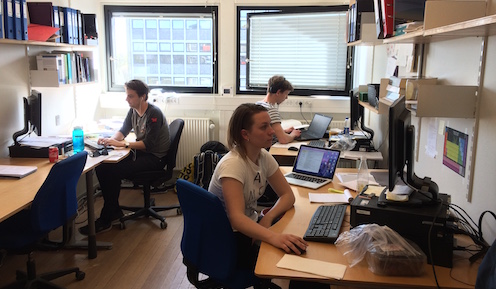
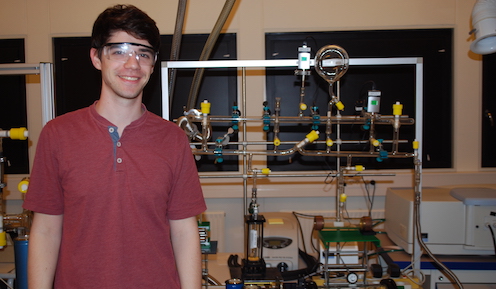
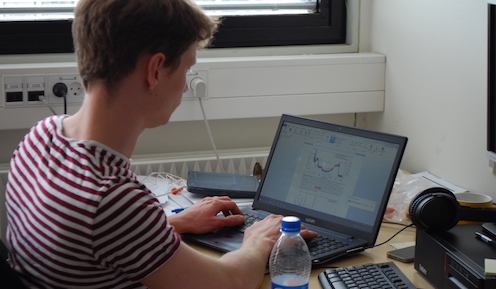
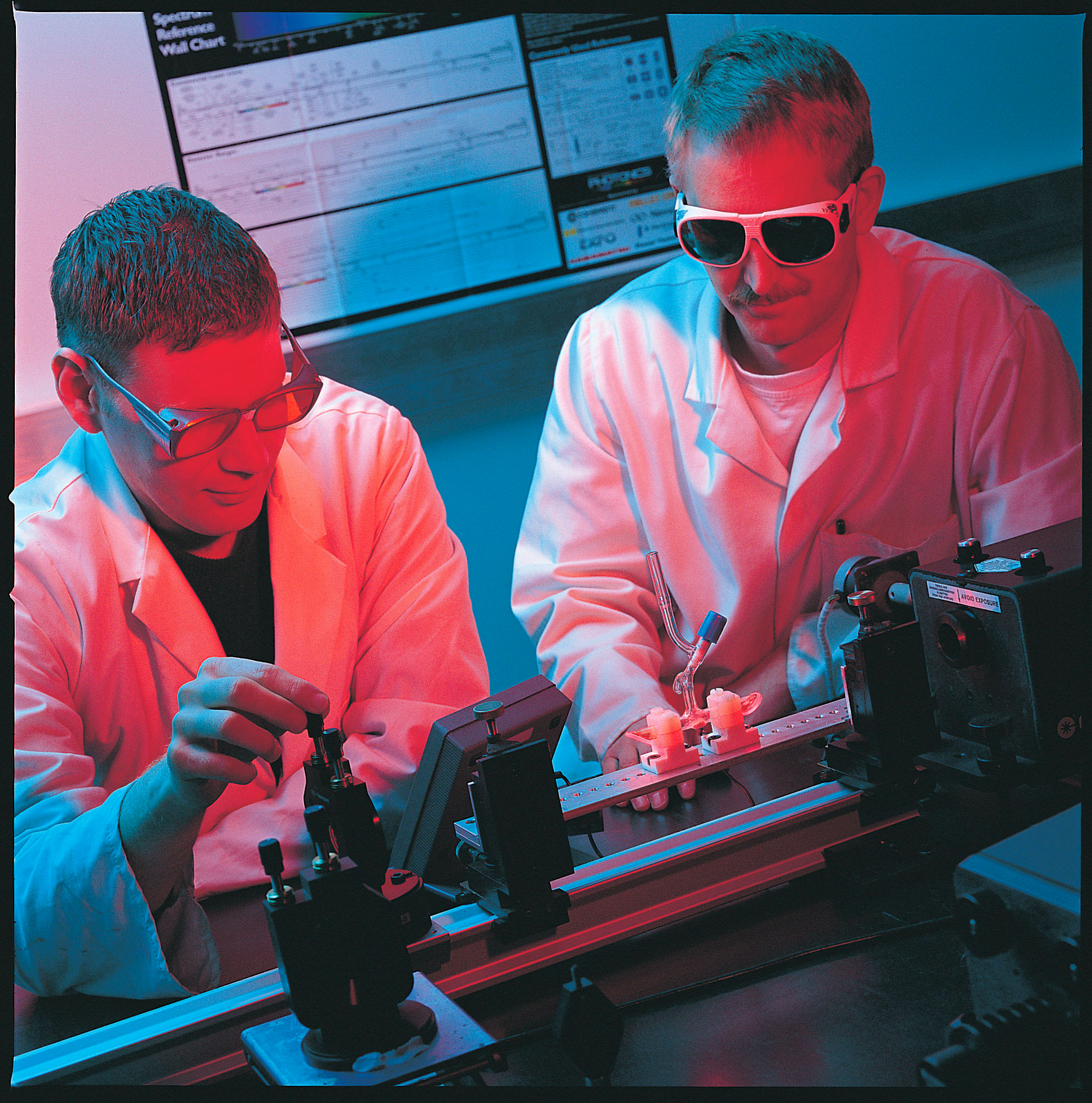
|


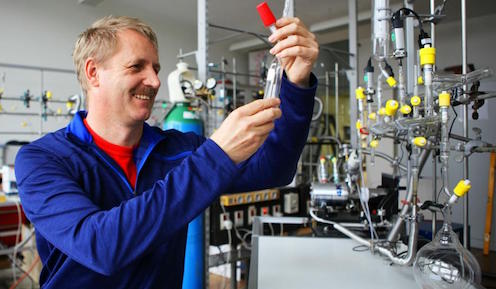
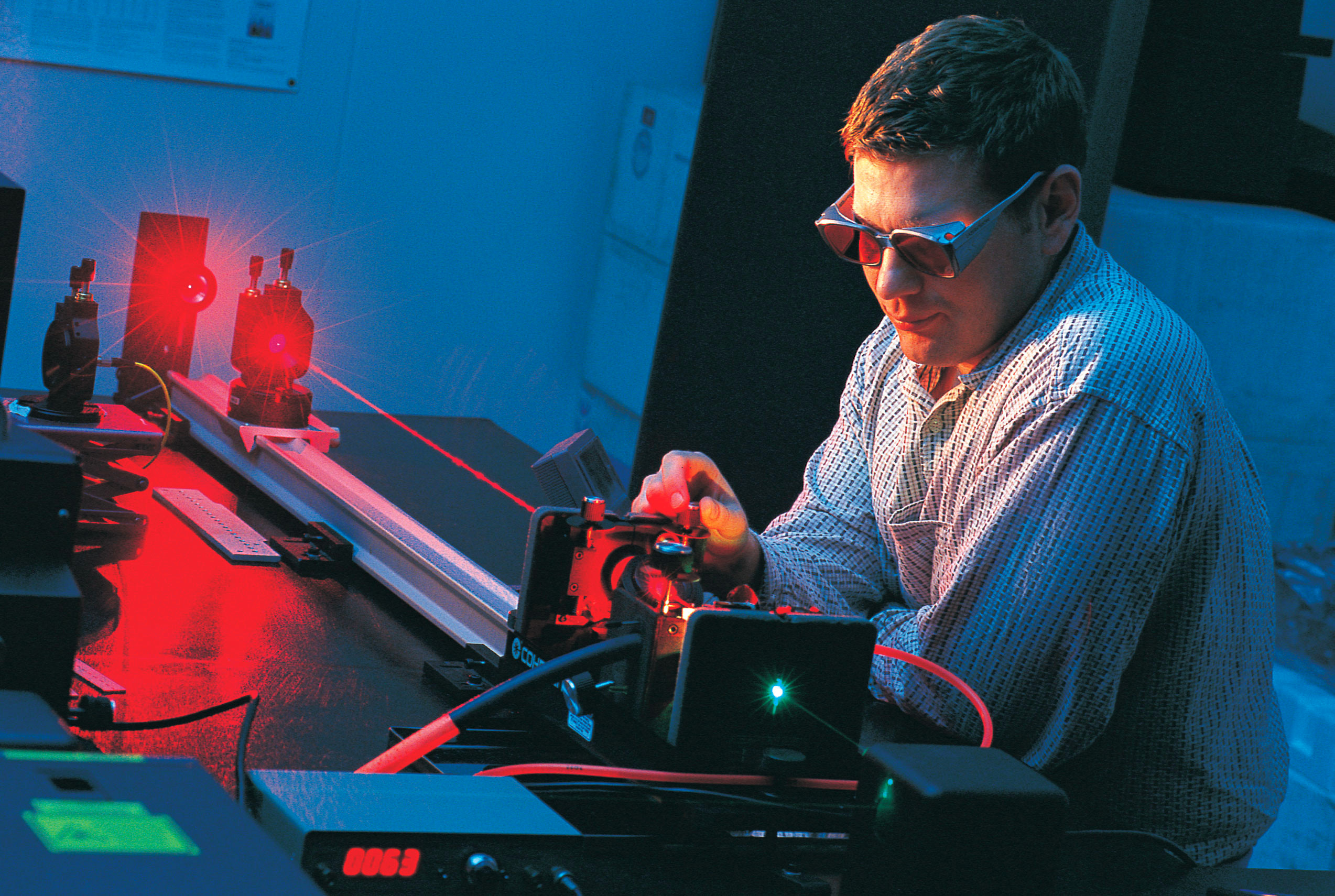
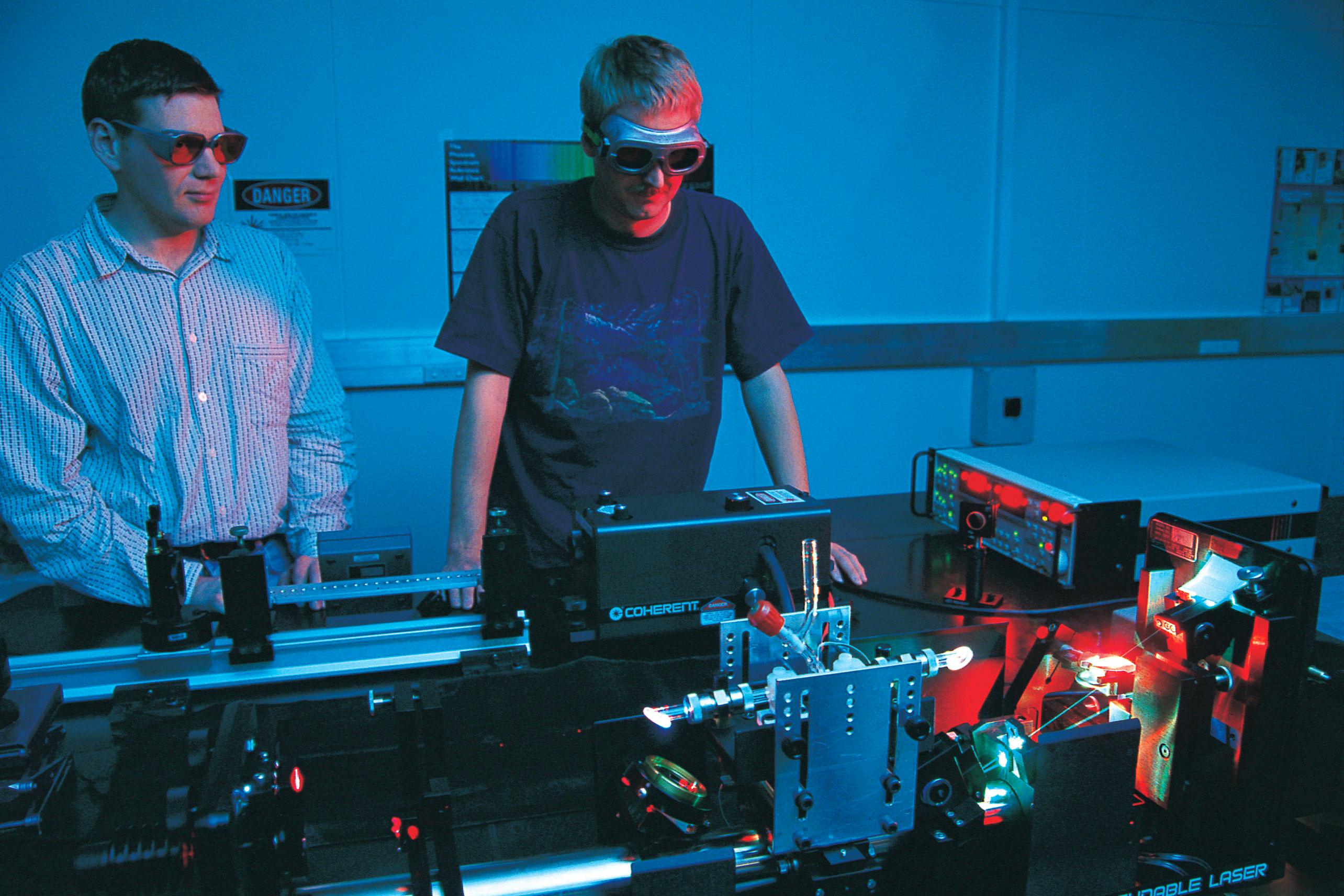
|
Photos from social events

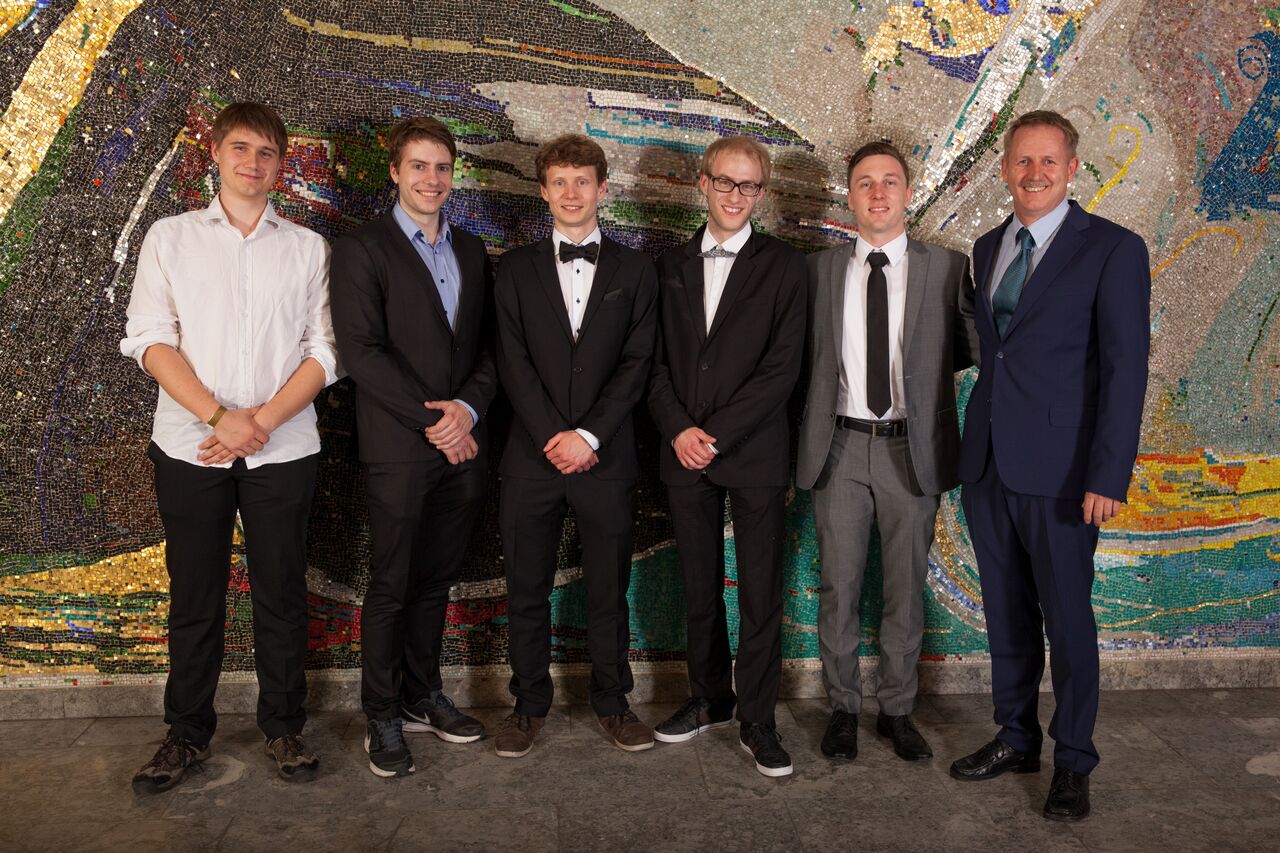

|
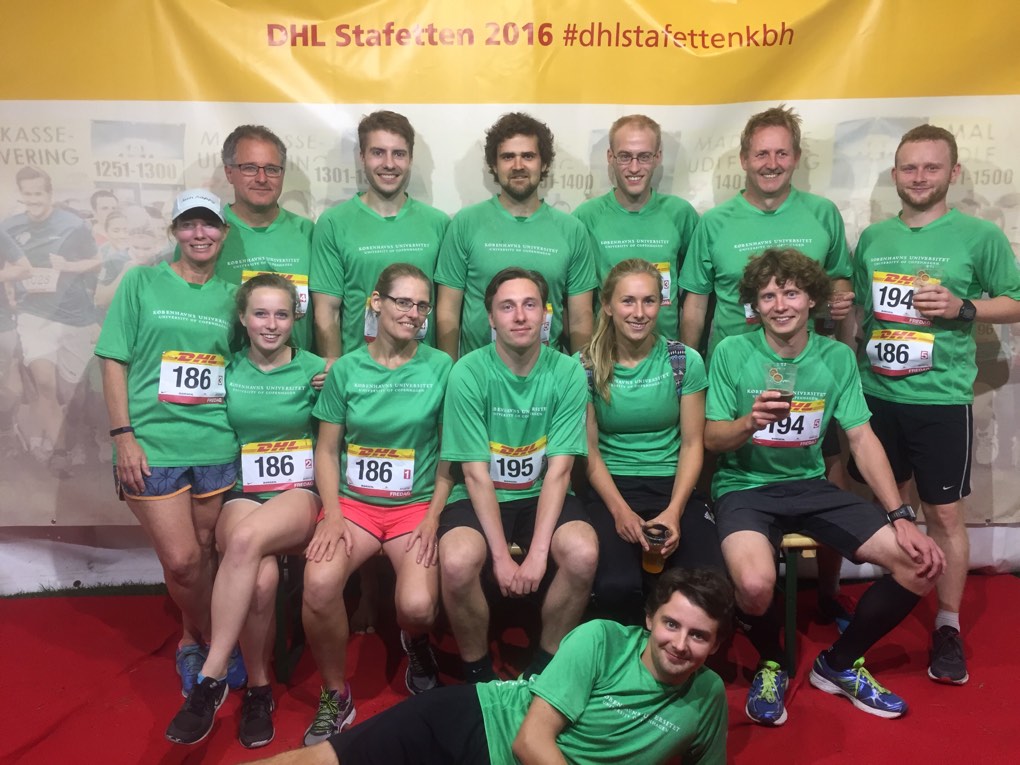
|
The Kjaergaard Group's laboratories and offices are located at The Department of Chemistry on the north campus of the University of Copenhagen in the H. C. Ørsted Institute building complex at Universitetsparken 5, 2100 Copenhagen.
 Professor Henrik G. Kjærgaard
Professor Henrik G. Kjærgaard
Email: hgk@chem.ku.dk
Office: Department of Chemistry, C418
Phone: +45 35 32 03 34
Address: Universitetsparken 5, 2100 København Ø
How to find us
The Kjaergaard Group is on the fourth floor of the C-building (Building 2) of the H. C. Ørsted Institute building complex of The University of Copenhagen (Department of Chemistry, Universitetsparken 5, 2100 Copenhagen Ø).
Reach us by public transportation
Use Rejseplanen to find your way to The Department of Chemistry by public transportation.
Most Recent Publication
242. Multireference and Coupled-Cluster Study of Dimethyltetroxide (MeO4Me) Formation and Decomposition
Vili-Taneli Salo, Jing Chen, Nino Runeberg, Henrik G. Kjaergaard, and Theo Kurtén











